59 Types of Vending Machines (for Your Vending Business)
January 17, 2023
January 17, 2023
Are you looking to start a vending machine business? Maybe you’d like to add new machines to your business. Either way, we’ve got you covered with 59 types of vending machines to help you grow your vending machine empire!
We talked with Adam Hill of Hill Vending to learn everything we could about starting a vending machine business. He shared tips on his favorite brands of machines and where to get them. We combined that with research to find a variety of machines and help differentiate a vending machine business.
We’ll answer questions like:
Let’s start exploring the world of vending machines.
According to Smithsonian Magazine, the first vending machine was created in the first century A.D. to provide controlled pours of holy water at temples because people took more than they paid for. I can’t say I am shocked that people tried to cheat the system that long ago, but I am surprised that the design is remarkably similar to more modern vending machines created in the late 1800s and early 1900s. The process was:

The world contains too many vending machines to count them all, but I found 59 types of vending machines to share with you.
In fact, you can find a vending machine for just about anything because vending machine suppliers will gladly build you a custom machine. Anything you could possibly sell, there are vending machines to sell them.
The primary types of vending machines are:
Adam told us:
Check out our interview with Adam below:
We’ll discuss these and many more to help you decide what types of vending machines are best for your vending machine business.
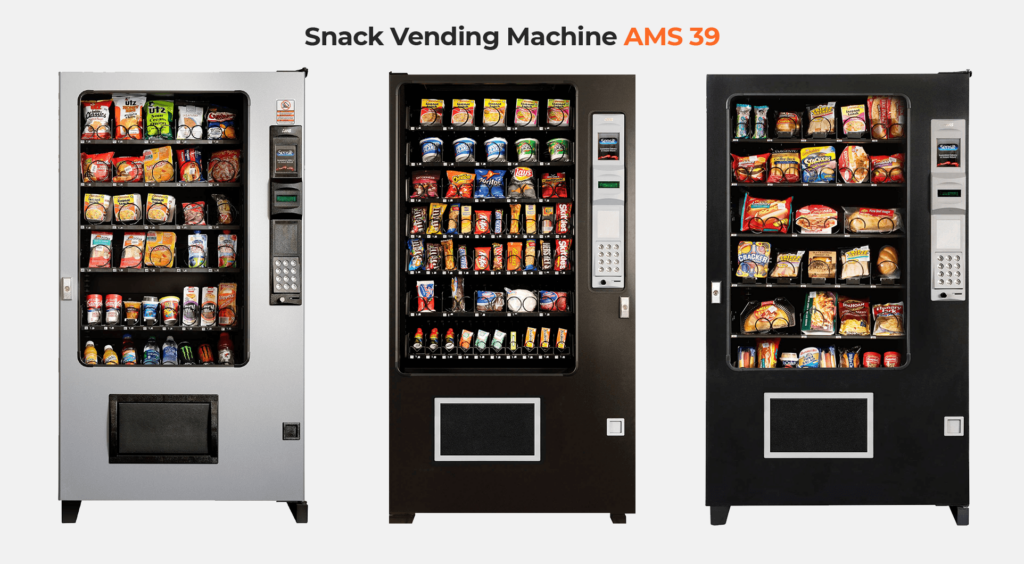
Snack machines are one of the most common types of machines for a vending machine business. As Adam said:
When you buy a snack machine, you’ll want to consider options like:
Now that we’ve discussed snack machines, let’s look at soda vending machines.
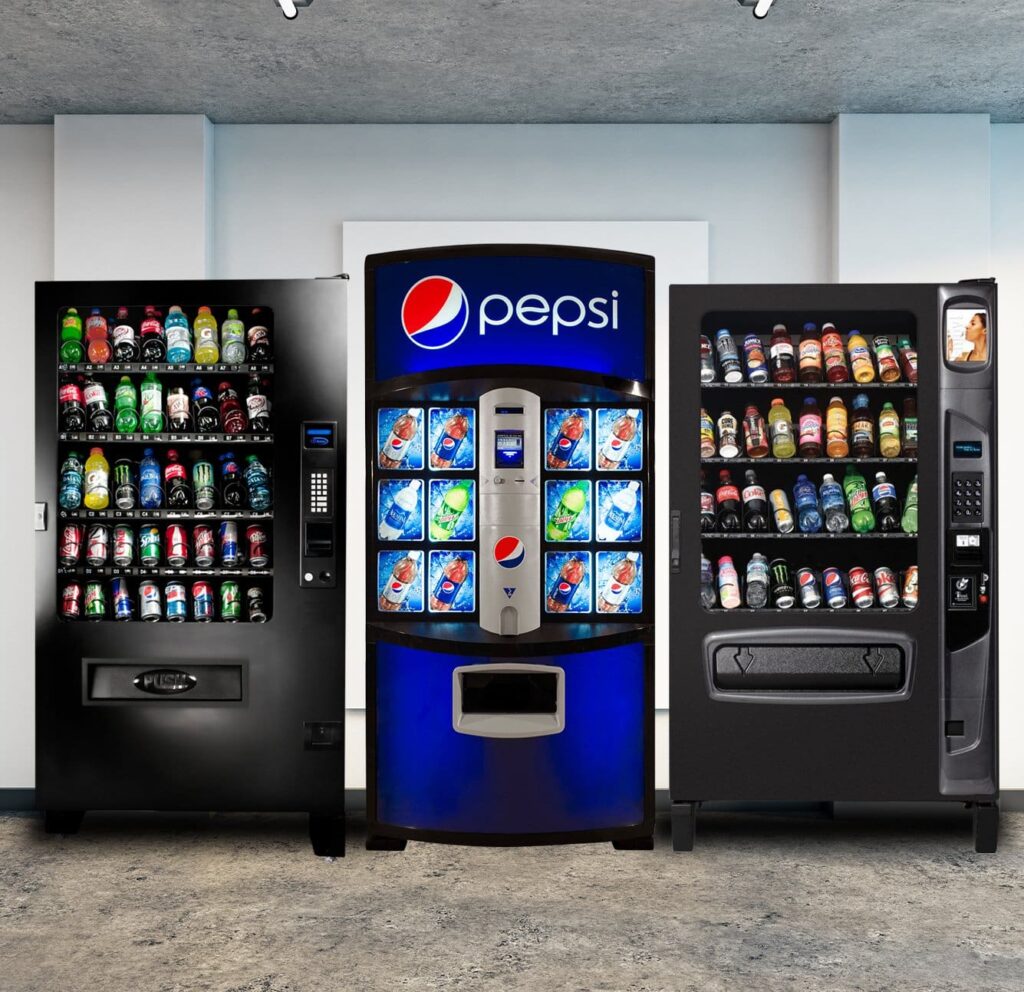
Soda vending machines have refrigeration decks that sell:
We see these drink machines almost everywhere we go. There are a variety of drink machines you can offer for selling soft drinks. The four main types are:
You can buy them used or partner with manufacturers like Coca-Cola or Pepsi that sell drinks to get new machines.

Vending machines that serve hot drinks like coffee and tea are also popular. These vending machines will normally look similar to the one below, but you can also get custom-made ones based on your interests. These work well in places like office settings.
You can also offer hot drink dispensing machines at gas stations. eVending.com offers the coffee vending machine below with financing for approximately $7 per day.

Put snacks and drinks in one machine. These make it easy to provide food and drinks to self-service workplaces. Vendo machines offer up to 70 slots for food and soft drinks in a single machine. Alternatively, you could go for the AMS Multitasker, which can hold bags of chips, candy, sandwiches, bottled drinks, and cans of soda. They advertise that Multitasker holds over 200 items.
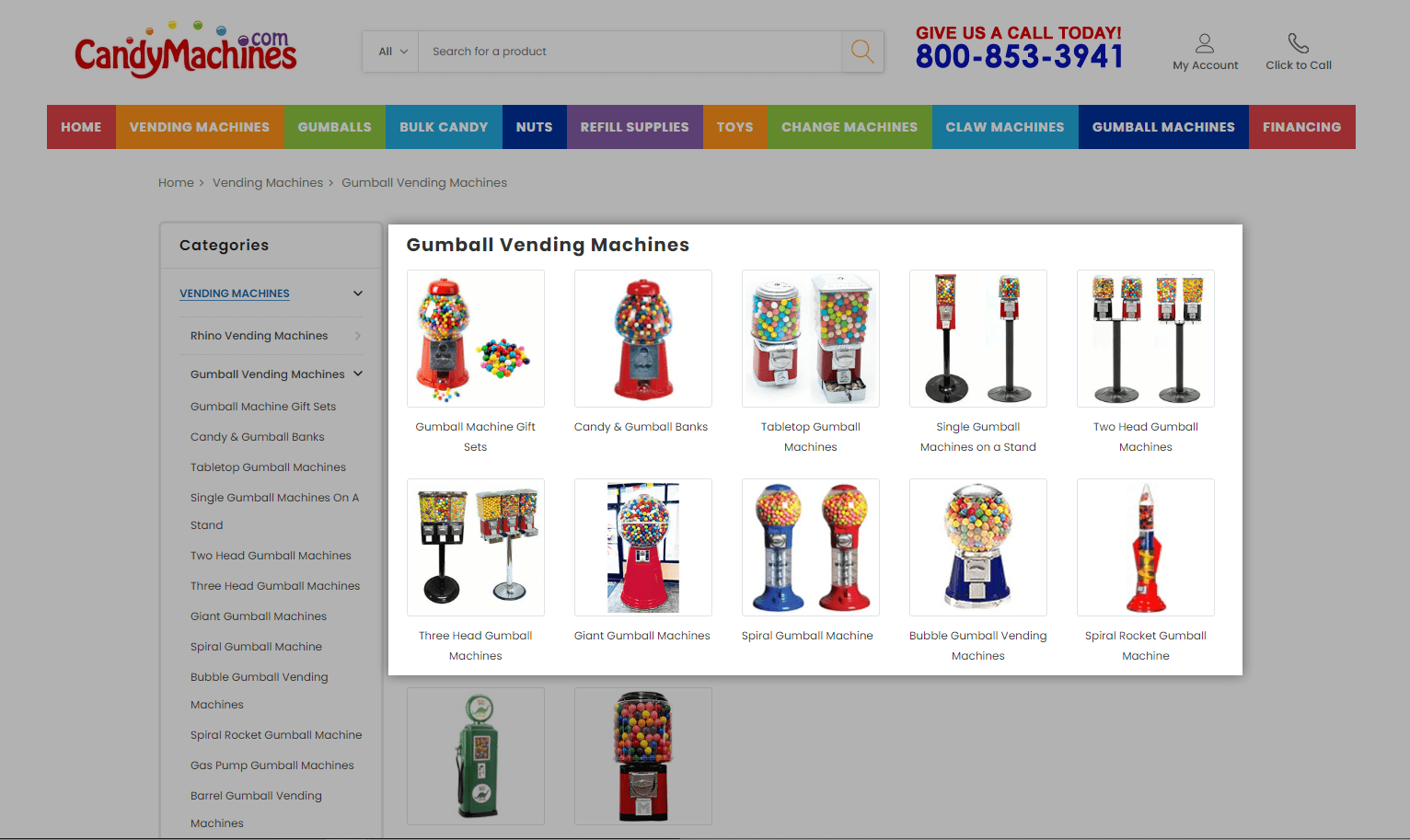
If your vending machine business includes retail stores en route, a bubble gum machine makes a ton of sense. Kids love them and they come in a variety of styles.
According to candymachines.com, there are ten types of gumball machines you might want to consider for your vending machine business.
Check out the slides below to learn more about each of these types of machines for a vending machine business.
A smart vending machine, or touch screen vending machine, is a step above standard vending machines. They use technology like inventory management software, social networking, and communicate with smartphone apps to make it easier to run your automated retail locations.
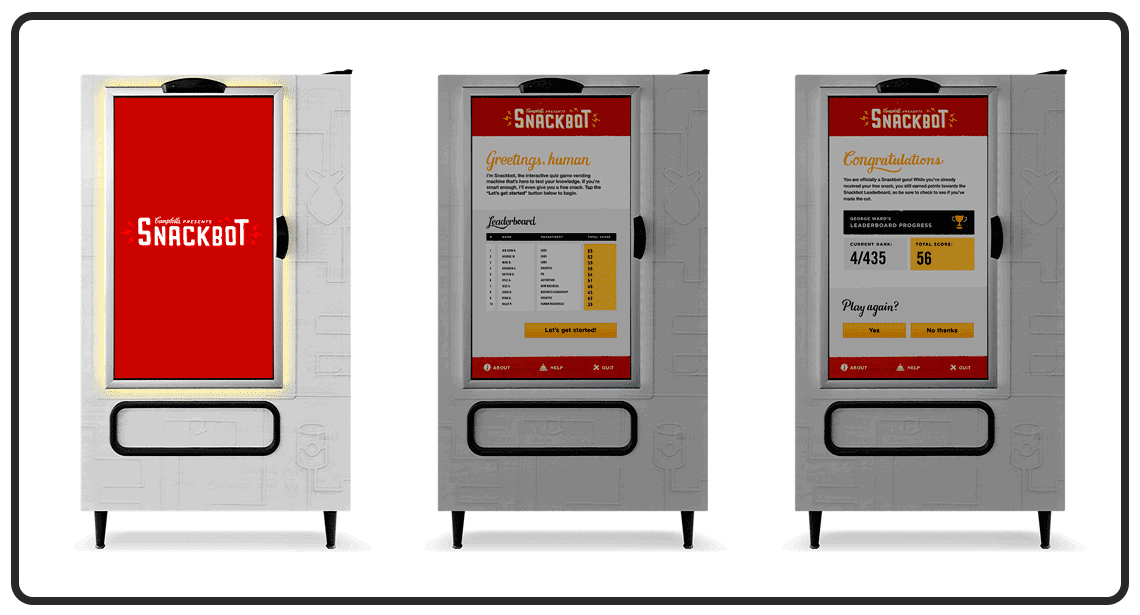
Combine your vending machine business with interactive quizzes. The Snackbot is used by Campbell’s Soup to quiz employees on the company’s culture. If they get two out of three answers right, it’s a free lunch. Can you imagine what this would do for culture building in office settings?
If you offer vending machines in high-traffic locations with different target audiences, you can use automated retail with social media activation. These types of vending machines offer business owners the chance to encourage customers to share items they bought with their smartphone apps. You can specifically tailor inventory to sports events, concerts, and other types of events all from one machine.
Check out Innovative Vending Solutions to learn about social media-connected machines.

Bulk machines can hold items like:
You can buy racks with up to 10 bulk dispensers to offer various snacks, gum, and toys.
Hot food vending machines help you sell foods like:
Consider a unique vending machine that serves hot food like the ones below.
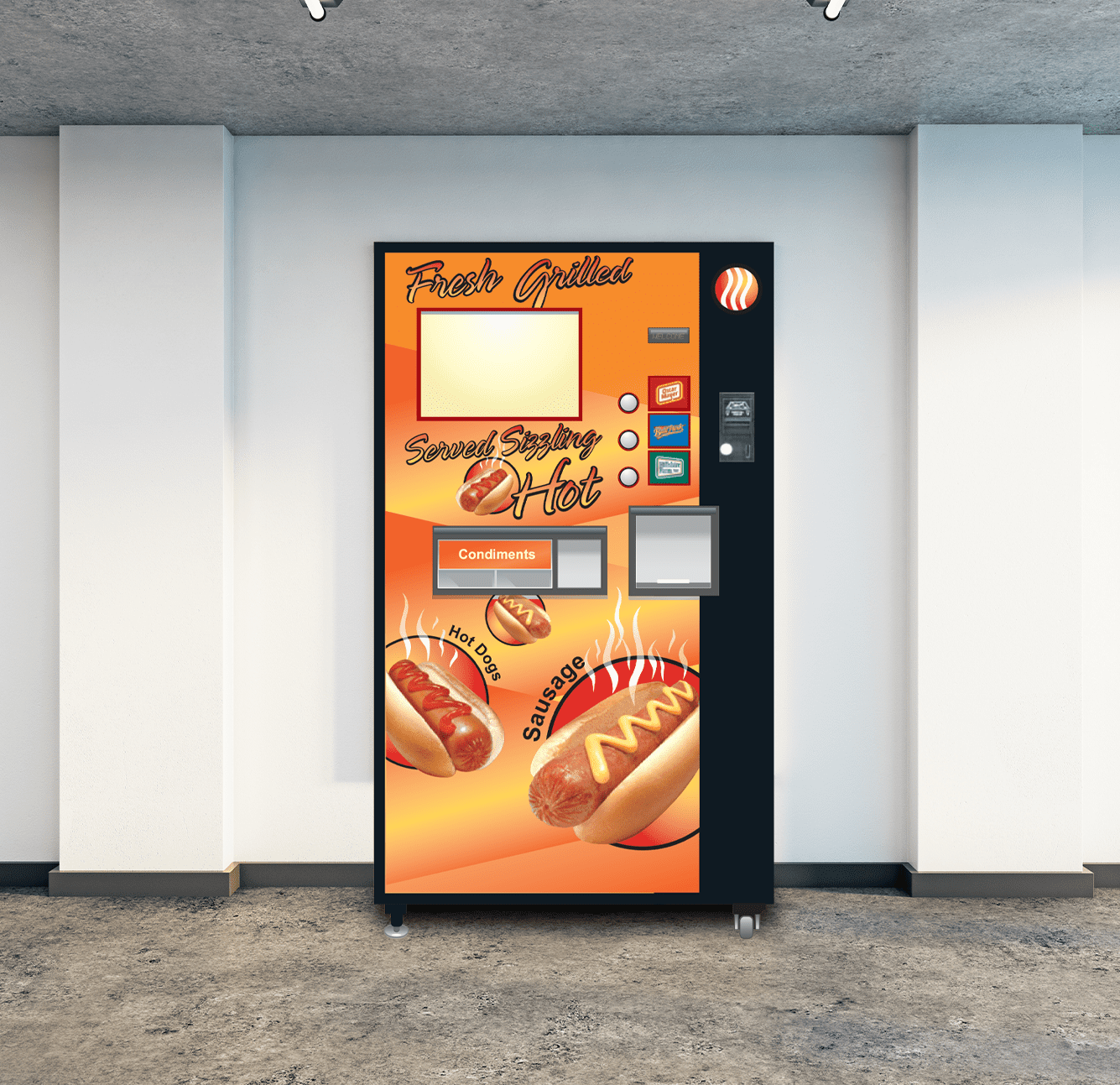
LHD Vending Systems created a machine that sells fresh hot dogs and sausages. It can hold up to 480 juicy wieners and 300 buns. Plus, you can add condiments and napkins dispensers. If you live in a town with a sports teams, I bet you could pay for one of these after a couple of sports events.

The Burrito Box is a custom smart vending machine that serves hot burritos and plays music while it cooks them. You can try it out if you are in West Hollywood, California or convince them to allow you to offer machines in your area.
I don’t know about you, but I love pizza! You can get a pizza vending machine from a vendor like Let’s Pizza. The pizza machine vending process takes three minutes to create the dough, add toppings, cook, cut, and box a full pizza. That’s super cool! Check out their video below:
If pizza isn’t your thing, how about hamburgers? There are vending machines that will cook a fresh burger with toppings—even toasting the bun! It’s an exciting time to be a vending business owner. Check out the RoboBurger video below:
I have no idea if this is any good or not but Maggi, a subsidiary of Nestle, and 7-11 convenience stores partnered to create a mashed potato dispensing machine. Gas stations get away with some crazy things because they are high-traffic locations. If it’s as good as their brownies, be careful. They’re addictive.
French fries are another one of my favorite foods. This fresh french fry vending machine is made by a European company, so we’ll have to excuse them for using the inches symbol to display seconds. Their machines cook fries in 35 seconds and their website is awesome! Check out Integra Systems.
Cold food machines come with a refrigeration deck to keep food at lower temperatures. This type of vending machine can be broken down further into:
We’ll look at each of these machines to help you understand how they are different.
Refrigerated vending machines are perfect for sandwiches. Make sure to check the temperatures of the machines when ordering them because most food and drinks need to stay between 32 and 40 degrees for cold food.
You’ll also need this type of vending machine if you operate at outdoor visitor attractions where the products would melt in the heat. These will normally be a combo machine that can be used for:
Refrigerated machines offer increased features and add-ons including weather protection, glass heating elements, and vandalism protection devices that help maintain the life of the vending machine in outdoor visitor attractions. They come with a much higher cost and Adam told us:
Consider a machine from AMS if you choose to go this route.
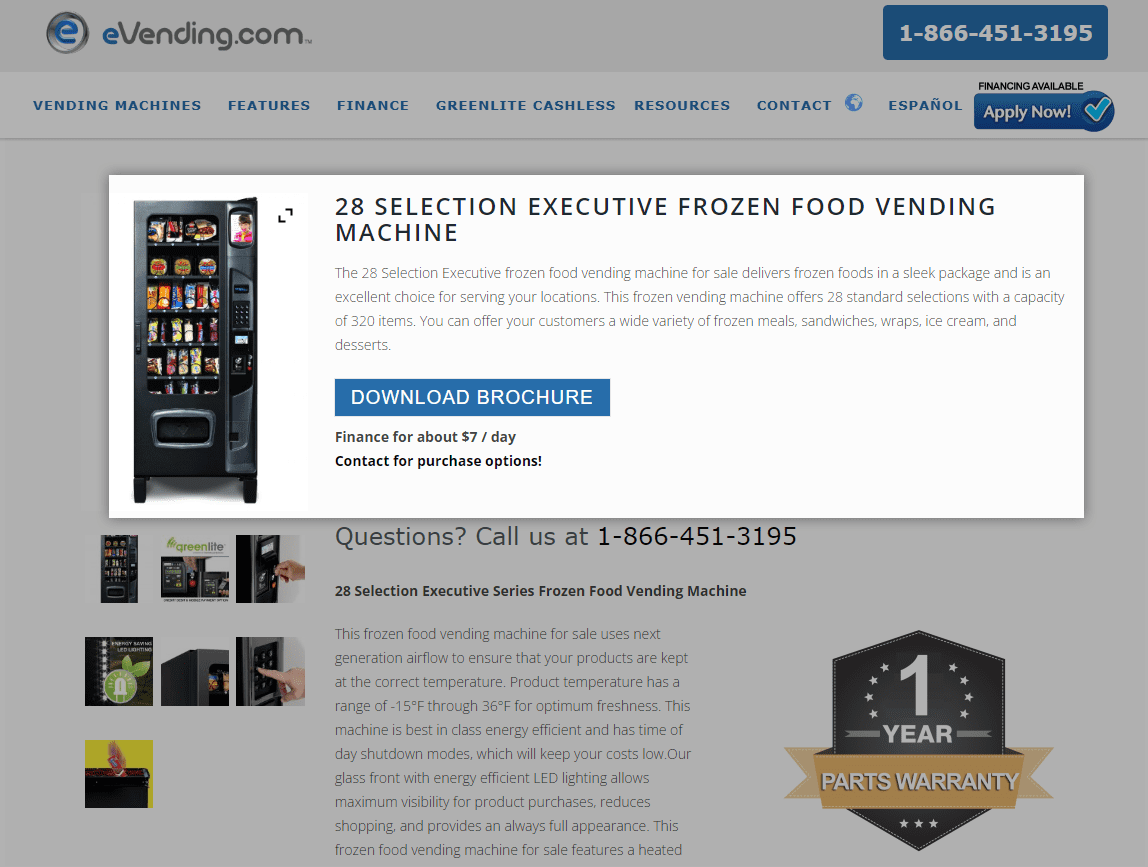
A freezer vending machine is designed to keep food below 32 degrees Fahrenheit. These are perfect for selling frozen snacks like ice cream. I could also see them being used to serve frozen margaritas in places that you have to be over the drinking age to enter. eVending.com offers frozen food machines with financing from $7 a day.
There are two ways you can serve ice cream. The first is using the machines above, but if you want a different type of vending machine, consider dispenser machines from iCream.
A dispenser machine will serve ice cream or soft serve (and toppings) into a cup based on the customer’s selections. These machines are sure to delight kids when they dispense an order.
Check out this news feature where they test the product:
Ice cream vending machine dispenses soft serve fast | KTLA
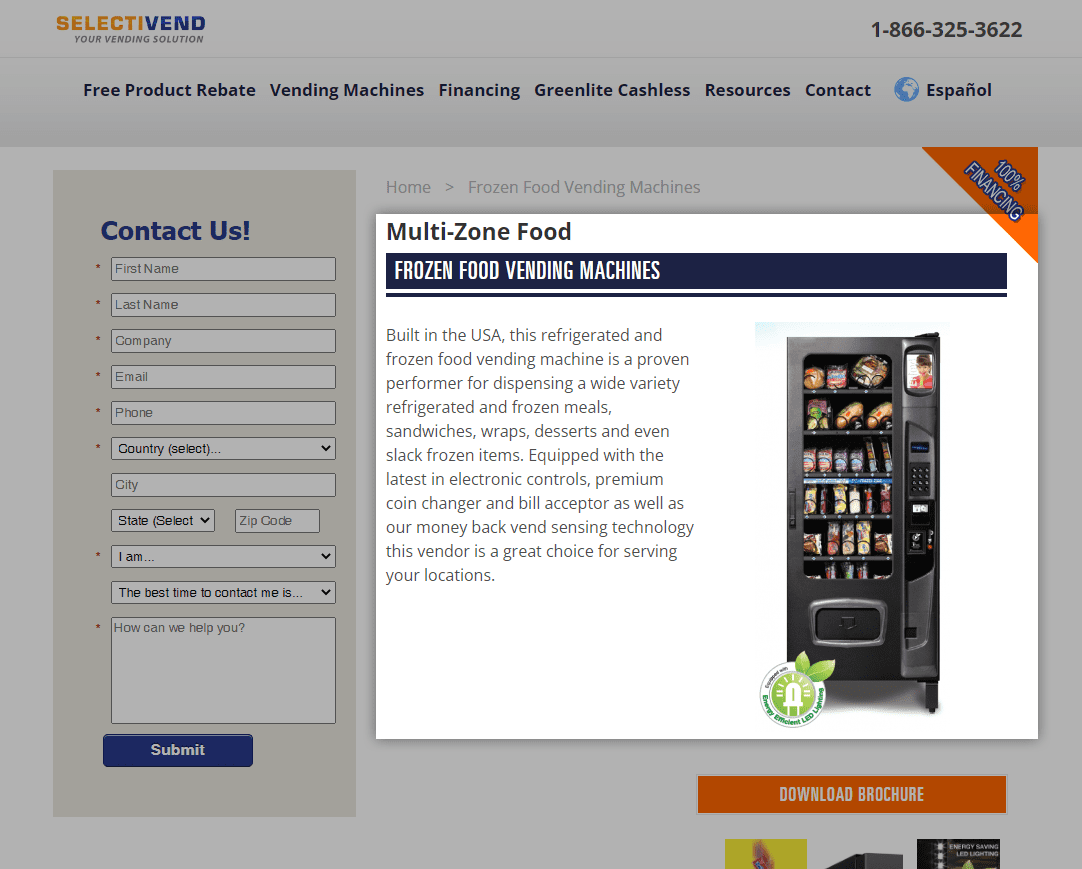
If you want one machine where you can serve cold food, soft drinks, and frozen food, you’ll want machines with dual-zone capabilities like the SelectiVend cold and frozen food combo vending machine pictured below. It allows you to set the temperature for each row to offer a combination of refrigerated and frozen snacks. Learn more.
A cigarette vending machine is used in places like casinos and bars to provide a convenient customer experience. These machines are less common than in the past because many locations no longer allow smoking. Most machines will be similar to AMS C36, but if you get one like the TCN vaping machine, you can perform automated ID checking, preventing sales to minors.
These are exactly what they sound like. They are miniature vending machines. They might be wall-mounted vending machines like the ones from Digital Media Vending or the bulk candy vending machines we discussed earlier.
If you buy an existing vending machine business, you’ll likely purchase at least one used vending machine. In our course about how to start a vending machine business, we’ll discuss purchasing existing routes.
Make sure to sign up if you want to learn the whole process of inspecting a used coin-operated machine thoroughly. Keep reading to learn more about other vending machine options.
Most of the time when a company refers to custom vending machines, the machines offer:
The machines offer a way to differentiate your machines from everyone else, but normally use the standard shells that you see with the most common vending machines. If you want something different than an existing vending machine model, you’ll probably want to go with a specialized vending machine. We’ll discuss those next.
These are unique vending machines that companies manufacture based on the needs of the business. The best example of a specialized vending machine is the Loose Leaf Tea vending machine pictured below.

Watch this vending machine percolate tea right in front of you. It’s definitely an eye-catcher. This is one of the coolest vending machines I came across in my research. I was not able to find the manufacturer which leads me to conclude this was a custom build.
The rest of this blog will be filled with examples of cool vending machines that business owners have created for their automated retail businesses.
Looking for something more unique than the various snack machines, drink machines, or combo vending machines? Check out some of these creative types of vending machines.

If you’re looking for an example of a vending machine for a high-end customer, look no further than the Gold to Go Machine in the Dubai Mall. These machines vend 24-Karat Gold in the form of gold jewelry, bars, and coins. Delight your customers with a glitzy high-end machine.

I live in Vegas, and these are everywhere! Casino hopping often means walking a mile, which I can only imagine is hard to do in high heels. After a night of drinking and partying, these machines save ankles. If you’re in a tourist location, you might want to consider adding one of these models to your vending machine business. RollaSole is the name of the company in Vegas. Save Our Soles is in Canada. Both use custom machine vending.

Nanjing, Jiangsu Province in China has vending machines that sell live crabs. These weird vending machines might dispense products that are a little crabby, but keep reading for some fun types of vending machines in the USA.
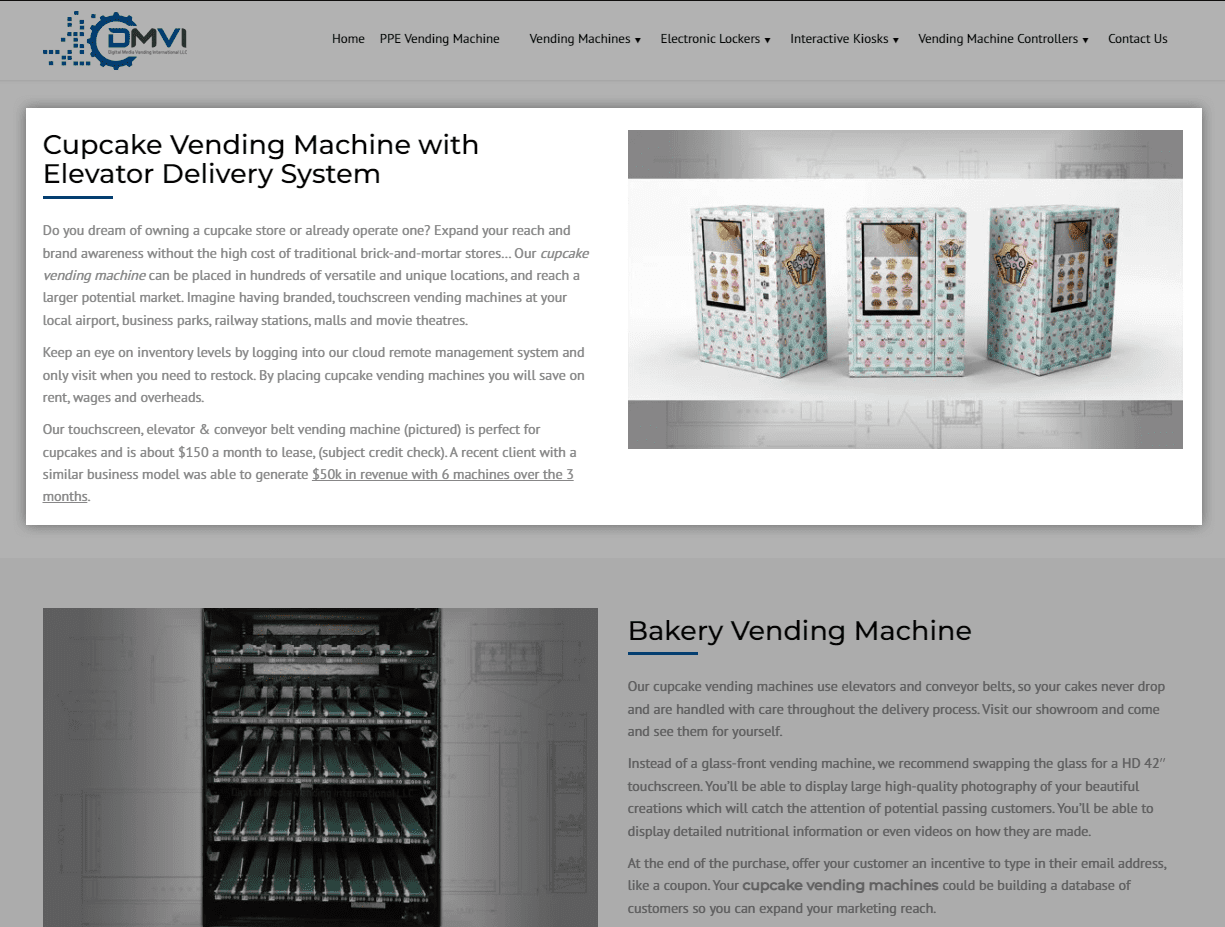
These machines are awesome! They have them in Las Vegas. These are the perfect compliment for a bakery to get more business. You can order them from Digital Media Vending. They claim one of their clients is averaging nearly $5,600 monthly revenue per vending machine.
Alternatively, you can buy a Sprinkles franchise which includes a cupcake vending machine in their stores.

If you know any farmers, you might want to take inspiration from these European vending machines. Lease these drink machines to them and let farmers fill them with their cows’ milk.
Find inspiration from this existing vending machine model. Start a beauty vending machine business and sell items like braids, makeup, fake lashes, feminine wipes, and other items. You can get your own custom vending machine from Discount Vending.
If your vending machine business services bars, you might want to consider offering a coin-operated breathalyzer testing machine. Save the bar and its customers from costly lawsuits with a machine like Breathalyzer in Every Bar.
VendRite specializes in vending machines for laundromats. If you have a route with a laundromat, offer to place a vending machine to help them sell products.
Some clever machines offer an old-timey look but function as modern vending machines, while others offer a sleek modern facade. Sell healthy food with these self-service workplaces. Reach out to Farmer’s Fridge to do business with them.
Pet-friendly combo vending machines offer snacks for customers and their dogs in an adorable vending machine. Offer these at places that are dog-friendly like parks and outdoor spaces to have the most success. You can apply to start a franchise on Franchise America. It costs around $4,200 and up, depending on the number of locations you’ll have. If you buy more than three Hey Buddy machines, you can go to a one-day training at their Dallas office.
Serve everyone’s favorite bubbly with a Moet & Chandon vending machine. You can find this drink machine in London, but I bet they’d love to have them in other classy locations.

Found in bathrooms around the country, this is a popular method of making sure people practice protection. They are also a popular method for offering products like laundry soap and toiletries for weary travelers. Find condom vending machines from Amazon.
The link above also works for medical vending machine products like headache medicine, Tums, and other commonly needed products that are safe for vending machine health sales. Make sure not to sell anything that requires a prescription.
Sports events and outdoor visitor attractions could use beer and sake vending machines to help cut down lines and increase business in high-traffic locations. Remember to make sure the machine has an ID scanner. Keep reading for other examples of unique vending machine business ideas.
Sticker vending machines are normally similar to bulk candy vending machines, but you could go with a different approach. With a smart vending machine, You could provide a business that accepts peoples’ pictures by text message and prints them on stickers, much like a photo vending machine.
Nuts are another product you can sell in the same machines as bulk candy, toys, and stickers. They are one of the healthier snacks people can eat, and it even helps some people balance their body chemistry when they eat this delicious snack (I’m one of them. Eating cashews helps with my anxiety and depression.)

Pecan pie is a southern favorite. Berdoll Pecan Farm in Cedar Creek, Texas sells pecan pies out of a vending machine to make it easy for customers to buy this hometown favorite. If you know farmers or restaurants that have a customer favorite, you might want to share this example with them to help make more money while delighting customers.
Bottled water is a necessity in a lot of places. You can offer:
There are even vending machines that can fill larger containers.
These aren’t around much anymore, but the old stamp vending machines were used to make it easy for people to get stamps for the mail. You might still be able to find them, but I wouldn’t recommend a stamps machine for a vending business in today’s digital world.
This manufacturer creates vending machines, self-service kiosks, and payment validators for slot machines. If you want to expand vending machine offerings to other industries, you might want to check out Crane Merchandising Systems.
Claw machines that people put in money to try to get toys, jewelry, or electronics are a popular sight at arcades, skating rinks, and other kid attractions. They can be really fun for kids and parents, too. You can find a variety of vending machines like this in Candy Machine’s Game Room.
A vending machine that can paint fingernails? Yep! And they’d be great to offer in places like wedding venues and high-end hotels where someone might want their nails done quickly. Check out this video by Clockwork. You can apply to lease their machines on the site.
Did you know you can sell cars via Carvana vending machines throughout the country?
They partner with car dealerships to sell cars, and anyone who refers someone to them can receive $100 per purchase. This can be a great way to supplement income to your vending machine business. Get a referral code, create QR code stickers, and add them to your snack vending machines (or any machines). Find out more about Carvana.

Coin-operated, old-school machines were once prevalent in places with heavy foot traffic. This style made it convenient for people to get the daily newspaper. Most of these vending machines were owned by newspaper delivery companies and serviced by their top-performing delivery route drivers. The picture below is an example from Vending Connection.
You can place book vending machines in places with plenty of foot traffic like schools, malls, daycares, or anywhere with kids that might want a new book to read. You might also have success with placing them in airports to give travelers something to do. Consider a kids’ book vending machine like the one pictured below. You can get it from Global Vending Group.

These machines are great for sports events, amusement parks, or anywhere people are celebrating. Customers love taking fun photos with each other. You can find various types of machines on Birmingham Vending. I want to check out the Marvel Adventure Lab and turn my family into superheroes.

If you live in a state with legalized marijuana and have the proper licensing, you could offer cannabis vending machines from American Green. The marijuana vending machine is a climate-controlled dispensary that even checks ID.
Imagine a machine that could make plastic figures, before 3-D printing. The machines were built in the 1960s, but you can still find some operational in museums and zoos across the country. You can find information on Mold-A-Rama locations and supplies, but construction of the machines was discontinued in the mid-1960s.
At one-time vending machines could sell life insurance in airports, but they were discontinued because lawsuits kept ruling against the insurance providers. If you start a vending machine museum, you might want to get your hands on one of these. Keep reading for more information on other types of vending machines.
In recent years, CBD has been used in almost everything… candy, lotion, soda, and various snacks. CBD is a health craze these days and there are vending machines for it, too. Green Box is a popular CBD vendor. You can find information about their automated dispensaries on their website.

Sometimes life is stressful and customers need to relax. A vending machine business might consider offering several different machines in office settings, conference rooms, and airports. Consider these massage chairs from the Massage Chair Store to get customers relaxed after a hard day.
You can offer hygiene items like toilet paper, feminine products, and other common low-cost items. Adding commonly purchased items to vending machines outside of large retail stores might add value to their customer services. You could act as the caretaker.
Check out our other blogs about vending machines including:
Then sign up for our Vending Machine Bootcamp.
Now that you know about the various types of vending machines, choose several different machines and become proficient with them. Adam told us:
You can check out the two brand he prefers on our vending machines for sale page where we help you find the best locations to buy a vending machine.
What are other examples of vending machines you’ve seen?
To learn more about starting a vending machine business, sign up for our free course below:
Brandon Boushy
Whether you personally love coffee or are curious about capitalizing on the booming coffee and specialty drink market, you’re not wrong for thinking starting a coffee business could be the answer to all life’s problems.
Before opening super-successful Woods Coffee, Wes Herman was traveling all over the U.S. for work, not seeing his family as much as he'd like, and wanting to empower his kids to live better. You'll never believe how he did it.
[su_quote]We started the company as a homeschool project to teach our four kids how to start a business. We hoped they would love it so much that we could work together for a long time as we grew this new brand.[/su_quote]
The family started serving coffee in 2002 when their homeschool project got a $23,000 loan. Since then, Woods Coffee has steadily grown to 19 shops over the Northwest.
Here, Wes shares coffee business secrets like avoiding tying your funds up in real estate and buying used whenever possible. By the end of this article, you’ll know how to start the coffee shop of your dreams with any budget.
[su_note note_color="#dbeafc"]
We’ll cover the following (click any link to jump to the part that interests you most):
If you want to know how to start a coffee shop, keep reading to find out how Wes started his multi-million-dollar coffee empire without spending his own money.

A coffee shop is a small restaurant, cart, kiosk, or drive-thru that primarily sells coffee, tea, and other refreshments.
Popular styles of coffee include:
A coffee shop might also carry small snacks like cookie cakes. A coffee shop owner might also consider opening a café, which tends to have more tables and a full menu of food in addition to coffee.
Keep reading to learn about the coffee industry.
Opening a coffee shop can be an exciting and rewarding venture, but it also requires careful planning and execution. You’ll need to perform the following steps to start a coffee shop:
Get ready to learn how to open a coffee shop.
The first step to starting a coffee shop brand is to research coffee businesses to understand how to place yourself within the industry. You’ll have two considerations during the market research phase:
Opening a coffee shop can be a lucrative business, but a new coffee shop needs to understand the startup costs, earning potential, fixed and variable costs, and marketing strategies of a successful business.
Companies like Starbucks, Dunkin, and Tim Hortons make hundreds of millions, if not billions, of dollars each year.
That’s awesome for them, but an independent coffee shop will take years to reach that point. Here, we help you explore your business opportunities for becoming a successful coffee shop starting from scratch.
We use IBIS World for all of our industry reports. They provide multiple reports about coffee shops, and there is some contradictory information.
We used the following coffee shop reports in the Industry Section:
We combined data from multiple reports because Starbucks gets nearly 40% of U.S. coffee and snack shop revenue. In addition, the NAICS report indicated that the industry operates at a loss when you exclude Starbucks.
The chart below is the coffee shop data from OD6098 and NAICS Code 72221B. This gives you a more adequate view of coffee shops by the numbers than including just one report's information.
| Statistic | Coffee Retail Markets | Coffee & Snack Shops | Combined | Starbucks | Coffee Retail Markets Plus Coffee & Snack Shops Minus Starbucks. | Coffee & Snack Shops Minus Starbucks |
| Revenue | $46,200,000,000.00 | $54,500,000,000.00 | $100,700,000,000.00 | $18,500,200,000.00 | $82,199,800,000.00 | $35,999,800,000.00 |
| Profits | $3,400,000,000.00 | $1,900,000,000.00 | $5,300,000,000.00 | $2,439,200,000.00 | $2,860,800,000.00 | -$539,200,000.00 |
| Profit Margins | 7.36% | 3.49% | 5.26% | 13.18% | 3.48% | -1.50% |
| Number of Locations | 455,929 | 89,867 | 545,796 | 15,991 | 529,805 | 73,876 |
| Number of Businesses | 342,120 | 72,136 | 414,256 | 1 | 414,255 | 72,135 |
| Location Rev | $101,331.57 | $606,451.76 | $184,501.17 | $1,156,913.26 | $155,151.05 | $487,300.34 |
| Business Rev | $135,040.34 | $755,517.36 | $243,086.40 | $18,500,200,000.00 | $198,428.02 | $499,061.48 |
| Loctions per Business | 1.33 | 1.25 | 1.32 | 15991 | 1.28 | 1.02 |
| Rev per Employee | $24,200.00 | $59,100.00 | $35,522.27 | $46,020.40 | $33,787.58 | $69,197.65 |
| Number of Employees | 1,912,595 | 922,246 | 2,834,841 | 402,000 | 2,432,841 | 520,246 |
| Average Number of Employees per Location | 4.19 | 10.26 | 5.19 | 25.14 | 4.59 | 7.042151714 |
| Profit per Employee | $1,780.95 | $2,060.37 | $1,869.59 | $6,067.66 | $1,175.91 | -$1,036.43 |
| Profit per Location | $7,457.30 | $21,142.35 | $9,710.59 | $152,535.80 | $5,399.72 | -$7,298.72 |
| Profit per Business | $9,938.03 | $26,339.14 | $12,794.02 | $2,439,200,000.00 | $6,905.89 | -$7,474.87 |
The average coffee shop location makes between $150K and $600K per year with 4-10 people working at the shop, but the exact amount will depend on the coffee shop concept, foot traffic, and number of employees.
If you’re opening a coffee shop or coffee cart as a solo entrepreneur, know that you might make as little as $24K a year, though.
Pro Tip: Plan ahead from the start. Scaling and acquiring an existing coffee shop is how most of the industry improves revenues and profit margins.
Depending on the coffee shop location and other factors, you can expect to make somewhere between $40K and $50K per month, but the average Starbucks location approaches $100K monthly.
These numbers will fluctuate seasonally and based on the number of days in each month.
Independent coffee shops will obviously make less in monthly sales than a Starbucks until they develop a reputation and get repeat customers.
An average coffee shop makes between $410 and $1,650 per day, while the average Starbucks makes nearly $3,200 per day.
Coffee shops tend to have the most business when people go to work, during lunch breaks, and after work. Of course, a great coffee business in a place like an airport or casino might have different high-traffic times.
Get ready to find out if a coffee shop is profitable.
It’s getting harder to measure profits because business owners have established that the ideal profit amount is zero to minimize their tax consequences. That said, a coffee shop can make up to 50% gross profit and 17% net profit.
Wes shared the following about the profit potential of a coffee shop:
[su_quote]You can operate a small business very efficiently in coffee, and if you get a lot of customers, then you can make some serious dough.[/su_quote]
In Wes's case, that's definitely true considering he owns a multi-million-dollar coffee shop empire!
Estimating how much coffee shop owners make requires analyzing various financial reports since a business owner may make money in the following ways:
You might make much more if you open a coffee shop like Woods Coffee. They have 19 stores and make millions per year. In that scenario, your salary would be comparable to a CEO or Operations Manager, tips would be removed, and dividends would be much higher. Check out our interview with Wes below to learn more:
[su_youtube url="https://www.youtube.com/watch?v=FOdRRuI4g5E"]Just because a spot is centrally located doesn't mean it’s the right coffee shop location.
High-traffic locations usually have sky-high rents and cutthroat competition. Meanwhile, a coffee shop starting as a coffee kiosk in a mall will have much lower costs and cover its operating costs quicker.
Pro Tip: Try to see potential in a location that nobody else appreciates. Wes has this to say about his Boulevard Park location, the crown jewel in his entire chain:
[su_quote]As an entrepreneur, you must trust what you see. It will always be different than what others see. There were quite a few businesses that passed on Blvd. Park because they couldn't see it working. We saw it from day one, never wavered, and built one of the finest coffee shops in the world.[/su_quote]
When you do your location analysis, consider the following factors:
Pro Tip: Learn more about picking locations.
Virtually every entrepreneur will tell you to write a business plan when opening a coffee shop.
Wes is no different. However, his coffee shop business plan was only one page long:
[su_quote]I always like to think that a business plan can be put on one sheet of paper. It's the difference between just driving aimlessly without a map versus having a map and understanding where you're going. You'll get there faster, you'll get there more directly, and you won't be distracted trying to figure out where you're supposed to be going.[/su_quote]
The beauty of the one-page coffee shop business plan is that it pares down your idea to its barest essentials. This helps you to focus on your vision with laser-sharp intensity. It makes opening a coffee shop so much easier.

You’ll want to include the following:
Pro Tip: You can create supplemental materials such as income and cash flow statements for potential investors but save them separately.
A business structure is just how your business is treated from a legal standpoint. It can be considered a separate entity, like a limited liability company (LLC) or corporation. Alternatively, sole proprietors and partners' personal and business interests remain legally connected.
Most business owners opt for an LLC through their Secretary of State website because it’s less costly than a corporation and limits their losses to the startup costs should the business fail. Your coffee business will also need an employee identification number (EIN) to file taxes.
Pro Tip: Learn more about the different types of businesses.

Complete all necessary paperwork to register your business with the appropriate local and state authorities. This will normally include:
Check with your city and state to establish exactly what you need.
Wes started Woods Coffee using none of his own money. Here's how he made it happen:
[su_quote]In those early days…we were on a very, very, tight budget. We didn't have the money, and so we needed to find the money, and we needed to be creative on how we launched the first store. So, the initial budget was $23,000—that's what we needed to pull this business off. We didn't have the dough, so we went out and asked someone to partner with us that had the money. They weren't coffee drinkers, but they decided that this would be a good investment, and it was.[/su_quote]
That's an excellent way to start a coffee shop with no money down! Of course, if you have savings or other sources of funding to work with, even better.
Wes thinks it would cost $500,000 to start a coffee shop today.
In our interview with Joe's Fine Coffee, Joe mentions that he was able to start his coffee shop for just $100,000. You can find that interview here:
[su_youtube url="https://www.youtube.com/watch?v=Fx7tEfEXLo0"]Our research shows that it costs about $275,000 to open a coffee shop. However, this will vary based on your location, business needs, and several other factors.
To determine your budget, you need to figure out what it'll cost to get your venture off the ground and calculate your ongoing costs. This will consist of the following three types of expenses:
Capital costs are things you only buy once (unless there is something from your equipment list that breaks down). These are things like:

Fixed costs are expenditures that stay the same from month to month. An example of this is rent.
Variable costs are expenses that fluctuate depending on how much business you do. These are things like labor costs because the more customers you have, the more employees you'll need to hire.
High startup costs mean that you're going to need plenty of startup capital to get your business off the ground. Here's what Wes has to say about that:
[su_quote]Most entrepreneurs forget about working capital and the need for a reserve to get you through the beginning stages of when you start your business… In most people's cases, they have to reserve enough money to get them through the first year to pay themselves.[/su_quote]
Set aside enough money to cover your expenses for six months (if not longer). An excellent strategy to minimize how much money you'll need is only securing enough cash to take you to the next stage of your business.
This is known as “the lean startup” and will dramatically increase your chances of success.
You can save money by holding down another job so you don't have to siphon funds from your fledgling business (that's what Wes did):
[su_quote]I worked for a good five years in another job so I wasn't a drag on the company and I was able to keep the money flowing into the company and able to make the company successful before I started drawing salary. So, we actually got to store number six before I ever started earning money out of the company. And I worked another job during the day, and then at night I'd make all the deals, and put these things together, and before you know it, we have six stores.[/su_quote]
With all this in mind, consider how you’ll fund your coffee shop. Your plan can include personal savings, loans, investors, or a combination of these.

Are you going to take a crack at crowdfunding or find a friend willing to invest in your idea like Wes did? Or, perhaps you have relatives who can loan you some startup dough?
You can always seek out venture capital or try to get a bank loan. Whatever funding source you turn to, you're going to need enough moolah to get through the inevitable lean times.
Pro Tip: If you think you need loans or investors, check out our blog on how to get a business loan.
Serving up a superior coffee experience is undoubtedly the most crucial aspect of your business. That's why you'll need to find an excellent source for your coffee beans, milk, syrups, equipment, and other necessary supplies.
In the beginning, it's probably best that you outsource the roasting of your beans.
When trying to find a supplier, look for:
Here's what Wes advises:
[su_quote]You certainly can hire somebody to roast your coffee for you. In our case, we wanted ultimate control over the process, the quality, and the consistency. And we can do that with our own coffee beans coming from specific countries.
How we control the roasting process is really important because we want to know that the process is done correctly, that it's fresh, and that it's done in the way we want it to be done.
So that's why we roast our own coffee. We didn't originally—that was a process that we had outsourced in the beginning years—but eventually, we were able to bring it in house and roast all of our own coffee, and that's been a huge advantage for us.[/su_quote]
As your profits grow, you might want to start thinking about roasting in your shop so that you have a unique product to offer your clientele.

Plan the layout of your coffee shop for both functionality and aesthetics. Consider factors like seating arrangements, counter space, and decoration. Check out some of these designs for inspiration.
Pro Tip: Want to get started with a coffee truck or cart? Get all the info you need from our Food Truck Ultimate Buying Guide.
Purchase essential coffee shop equipment like an espresso machine, grinders, brewing equipment, refrigerators, and furniture. Make sure they meet industry standards and regulations.
Wes says:
[su_quote]It's really critical to have the right machines.[/su_quote]
Check out part one of our interview with Wes below.
[su_youtube url="https://www.youtube.com/watch?v=FOdRRuI4g5E"]Try to get high-quality equipment, even if it's not new. If you get the cheap stuff, you'll only end up regretting it later on.
Here's the list of equipment you'll need to make your small coffee shop a resounding success:
As your business grows and your services expand, you might need other coffee shop equipment like coffee roasters.
One of the biggest lures of a gourmet coffee shop is the atmosphere. Create a relaxing physical space with the right décor, and make sure your café has lots of comfy seating, too.
Hire baristas, kitchen staff, and any other necessary employees. Ensure they are trained in coffee preparation, customer service, and health and safety protocols.
Stellar customer service is crucial when you own a coffee shop, so be selective when hiring new staff.
Although your baristas must know how to make beverages correctly, they should also know a little about the coffee itself. These are things like the flavor profiles of each specialty coffee and where the beans come from.
During training, you might want to teach employees about latte art, quality beans, and how to encourage customers to keep coming back.
This is need-to-know information for coffee connoisseurs, so your baristas must be armed with this knowledge.
Pro Tip: Learn more about hiring before you open your own café or coffee shop.

Create a menu that includes a variety of coffee beverages, tea options, snacks, and possibly light meals. Consider catering to different dietary preferences and restrictions.
When you open your coffee shop, you need to consistently serve the best coffee and snacks. If you succeed in doing this, you'll have customers flocking to you.
When it comes to creating your menu, keep in mind that you're not reinventing the wheel—you're taking the best food and drinks offered by the top coffee shops and finding ways to make them better.
There's no way a coffee shop can remain economically viable on coffee sales alone. That's why you need to offer bakery items. Having a delicious assortment of quality baked goods near the cash register will tempt the customer to buy.
Try to come up with at least a few menu items that'll dazzle customers with their originality.
Here's what Wes has to say on this subject:
[su_quote]It's how you can make something creatively different in this space that attracts people and maybe attracts a different market segment than you're normally pulling.[/su_quote]
Check out part two of our interview with Wes below.
[su_youtube url="https://www.youtube.com/watch?v=dbbPRvrUjYI"]Create a strong brand identity, including a memorable logo and a cohesive visual theme.
Develop a marketing plan that includes an online presence (website, social media), promotions, and possibly partnerships with local businesses.
You want to whip customers into a buying frenzy even before you open your doors.
One way to do that is a direct mail or email campaign sending out coupons for free coffee. Do a little research to find out what sort of marketing would be best for your coffee shop.
Here's what Wes has to say about that:
[su_quote]We actually don't spend a lot of money [on] marketing. It's changed over time. So when we first started, we were looking at what are other people doing, how are they marketing themselves, and we realized we didn't need to do a lot of marketing, we didn't need to put advertisements in newspaper(s), that was a thing, back 18 years ago… there was no Facebook, there was no website you could put up, and people would understand what you're doing. So, we actually realized that the best form of advertising for us was putting multiple locations within a certain geographic territory.[/su_quote]
When he first started out almost 20 years ago, his only marketing was opening up new coffee shops! Which, of course, is an atypical way to market yourself. Today, with the advent of social media, Woods Coffee has changed its marketing tactics:
[su_quote][Now], social media is big for us. We're pretty dominant in our space in this area on social media, and that's been a lot of fun. It's a great vehicle for us to show some of our creativity and how people understand who we are and what we offer.[/su_quote]
Obtain all necessary permits and licenses to operate a food and beverage business in your area. This may include health department permits, business licenses, and signage permits.
There are permits and licenses you're going to need before you can start serving customers. This is a long and drawn-out process, so make sure you start early.
Here's what you might need:

Conduct a soft opening to test your operations, gather feedback, and make any necessary adjustments before the official opening. These are normally days when family and friends are invited to try the menu.
This will give your coffee business a chance to work with the POS system and inventory management system.
Plan a grand opening event to generate excitement and attract customers to your coffee shop. Contact the local news or a PR firm to help you get the news out. Run paid ads with a promo.
Pro Tip: At the grand opening, encourage reviews by using a QR code to send customers directly to your shop's review page.
You’ll need to establish efficient operating procedures for ordering supplies, scheduling employees, managing inventory, handling finances, and maintaining equipment.
There are restaurant management systems that combine many of these into one system, or you can choose systems that work best for each process.
Pro Tip: Learn more about restaurant management systems.

Focus on providing excellent customer service, quality products, and a comfortable atmosphere to encourage repeat business and positive word-of-mouth.
Your customer service at a coffee shop is heavily impacted by a few things, including:
Although opening multiple stores was always a part of the Woods Coffee business plan, it happened much sooner than Wes thought it would.
That's because the opportunity to open a second coffee shop fell into their laps in the form of a perfect location they couldn't let pass by.
They seized this opportunity and opened their second store. It was also a way to show the world they were aggressive, growing, and owned their market.
Put a second store in a 6,000-resident town, and you’re going to get a lot of attention. The bold move drove sales in both stores, and they both grew dramatically!
You can do the same thing—just make sure you open your second spot in a carefully planned way. Wes told us having multiple business locations isn’t always the best approach:
[su_quote]It has to be part of your business plan. If you follow your business plan and have it laid out exactly what you wanna do, then follow it. You can't just change midstream. Some businesses are much more successful with just one location. In our case, it just happens to be part of our growth plan and part of our experience that we have multiple locations, and it was part of that original plan that we're executing today. But the idea of ‘How do you scale? How do you grow?’—it's really important. We don't put a lot of money into real estate and buying things. We'd really like to keep our capital fluid and moving. And if we can open more stores, we feel that's better for us.[/su_quote]

Donut shop coffee is typically an Arabica bean that pairs well with donuts. These can be anywhere from a light to dark roast, but they will normally be slightly sweeter than other coffee and work well with cream or milk.
A coffee shop bar is a section in a coffee shop where customers can order and enjoy alcoholic beverages in addition to coffee and other non-alcoholic drinks.
A café is similar to a coffee shop but will normally serve slightly more elaborate food than a coffee shop (without having either the size or the selections of a full restaurant).
If you do the proper market research, write and follow a solid business plan, and focus on continuous improvement, you should find success when you open a coffee shop.
Wes was able to open a coffee shop and grow it to 19 locations. That means you can, too!
What’s the signature drink you’ll use to build your multi-million-dollar coffee empire?
Did you know that approximately one in nine men owns a small business? If you want to join the ranks of small business owners, check out some of our best business ideas for men.
Many of these business ideas are working with your hands. Most of them make great money and will help you become more self-sufficient.
[su_note note_color="#dbeafc"]
Click on one of the businesses below to learn more about these business ideas for men.
Want to get the most bang for your buck? We’ll start our list with the most profitable business ideas, ones with a high return on your investment of time and energy.
Average Annual Revenue: $817K
Average Profit Margins: 6.9%
Startup Costs: $100-$10K
Time To Revenue: 1-6 months
Annual Market Growth Rate: 1.3%
Best for: Social media experts, people with strong digital marketing skills
These days, just about every business owner uses social media sites to connect with their customers, but not all entrepreneurs are experts in these platforms. That makes becoming a social media manager one of the most profitable business ideas for men with strong marketing skills and social media expertise.
While you can make good money in social media marketing as a one-man business idea, starting an agency lets you scale revenue even further. Eric Berman started Brandetize in 2001, and today the company earns an average revenue of $400,000 a month. Listen to his advice on how to get started here:

Average Annual Revenue: $400K-$1M+
Average Profit Margins: 14.5%
Startup Costs: $100-$50K, depending on size and scope
Time To Revenue: 3 months to 2 years
Annual Market Growth Rate: 3.1%
Best for: Programmers, software developers, digital design experts
An average of 250 million apps are downloaded every day, with $129 billion spent on apps in 2022. You can get in on this billion-dollar industry by starting your own business selling apps on the Google Play store or Apple app store.
One great thing about software or app development is the variety of revenue streams. You can sell the app itself, include in-app purchases, or design custom software for other businesses.
Whatever business model you choose, you don’t need much to get started. With just a few tools and coding skills, you can turn your app idea into a lucrative business venture.
How lucrative? Pace Ellsworth makes an average of $45,000 a month with his software development business. Find out more in this podcast interview:

Average Annual Revenue: $36K-$50K
Average Profit Margins: 5%
Startup Costs: $150-$500
Time To Revenue: 1-3 months
Annual Market Growth Rate: 25%
Best for: marketing, social media, and automation experts; organized and process-oriented entrepreneurs
If you’re looking for profitable one-man businesses you can start from home, dropshipping is an excellent way to earn money online with a small startup capital investment.
In a dropshipping business, you sell products that are made and stored elsewhere. The dropshipper markets and sells products to customers through their own website or online store but doesn’t need to store or ship the inventory themselves.
The UpFlip blog on how to start dropshipping has step-by-step advice for starting your own successful business in this niche. We also did a podcast interview with Heather Johnson, who started her print-on-demand dropshipping business as a side hustle and now makes an average of $15,000 a month in revenue. Hear her advice here:
Average Annual Revenue: $74K+
Average Profit Margins: 6.7%
Startup Costs: $1K-$30K
Time To Revenue: 1-6 months
Annual Market Growth Rate: 1.2%
Best for: Detail-oriented entrepreneurs, organizers and neat freaks
In the post-pandemic world, people are more concerned than ever with keeping their environment clean both at home and in the workplace. This makes a cleaning business a very profitable small business idea with a high demand.
There are a variety of models for a cleaning business. You can work with both residential and commercial customers or focus on a tighter niche, like home cleaning or janitorial services. You can also work with other local businesses like Airbnbs or apartment building landlords.
The UpFlip 7-Figure Cleaning Business Blueprint is an excellent resource for anyone who’s considering this profitable small business idea. You can also hear advice from course instructor Chris Mondragon in this YouTube interview:
[su_youtube url="https://www.youtube.com/watch?v=YcYIYdqegGA"]
Average Annual Revenue: $124K+
Average Profit Margins: 5.5%
Startup Costs: $1K-$100K
Time To Revenue: 6-18 months
Annual Market Growth Rate: 1.0%
Best for: chefs, cooks, bakers, and other food experts
Restaurant businesses can be very lucrative, but they require substantial financial resources to start and have a high failure rate, with 80% failing within their first 5 years according to the National Restaurant Association.
A catering business is an excellent alternative, with significantly lower startup investment and more flexibility than a brick-and-mortar restaurant business.
Connecting with other small business owners is a great way to grow a catering business. For example, you could sell grab-and-go options in a cafe, or partner with an event planning business to cater weddings, parties, or corporate events.
Average Annual Revenue: $41K+
Average Profit Margins: 6.4%
Startup Costs: $1K-$100K
Time To Revenue: 3+ months
Annual Market Growth Rate: 1.2%
Best for: outgoing food experts, chefs, and cooks with strong marketing and customer service skills
Another alternative way to get into the food retail industry is to start a food truck. Like catering, this is a profitable business idea for people who have cooking and customer service skills but lack the capital to start a full-service restaurant.
Like a catering business, a food truck offers lots of flexibility and room for growth. Carlo Chalisea started with a small food cart, expanding into a full truck and then into a restaurant as his business grew. Hear his story here:
[su_youtube url="https://www.youtube.com/watch?v=8MPTE67PYcY&list=PLaU6uY9Yy7XltYGQUA7hfYfjwCWGHgwiC&index=8"]
Average Annual Revenue: $1.52M
Average Profit Margins: 5.4%
Startup Costs: $100-$3M
Time To Revenue: 1-6 months
Annual Market Growth Rate: 1.1%
Best for: foodies, bakers, food service professionals
Another of the most profitable small business ideas for men who love food is to open a bakery. Like catering, there are multiple ways to start your own bakery business. One business model is to have your own storefront, like the 7-figure Wild Wheat bakery:
[su_youtube url="https://www.youtube.com/watch?v=j2_xwBgyFFU"]
You can also make bread and pastries for commercial customers like cafes and restaurants or sell baked goods directly to customers in an online store.
The variety of revenue streams you can explore is why a bakery is among the most profitable small business ideas in the food industry.
Average Annual Revenue: $182K+
Average Profit Margins: 4.3%
Startup Costs: $2K-$10K
Time To Revenue: 3+ months
Annual Market Growth Rate: 0.5%
Best for: organized entrepreneurs who like driving; people who want a semi-passive business
Vending machines are a convenient way to provide food and drinks in schools, workplaces, and other places people gather. A vending business is among the best business ideas for men who want full control over their schedule. It’s also one of the top business ideas for beginners since you don’t need special skills or equipment to be successful.
The start-up costs for a vending business vary widely. They can be as low as a few thousand dollars if you start with just a few machines, or $25,000 or more if you’re buying an entire route.
Adam Hill of Hill Vending walks through the process of starting a vending business step-by-step in UpFlip’s Vending Bootcamp. You can also hear some of Adam’s insights in this YouTube interview:
[su_youtube url="https://www.youtube.com/watch?v=-s_Y-O1nosw"]
Average Annual Revenue: $696K+
Average Profit Margins: 3.4%
Startup Costs: $1K-$100K
Time To Revenue: 1-6 months
Annual Market Growth Rate: -1.3%
Best for: skilled tradesmen, architects, builders, and real estate experts
The U.S. construction market was a $2.1 trillion industry in 2022, and that market is growing. General contractors and other construction professionals work with both residential and commercial customers, and both sectors are forecasted to grow over the next five years.
You will need to be licensed to run your own successful business in construction. You don’t need to go to school to get the necessary skills and knowledge, though. Vitaly from VP Homes learned the trade on the job when he was 18 and now builds custom homes for a very healthy profit (hear his advice in the video below).
[su_youtube url="https://www.youtube.com/watch?v=wuqVb9B58CE"]
Average Annual Revenue: $5M+
Average Profit Margins: 6.8%
Startup Costs: $100K-$3.5M
Time To Revenue: 6-18 months
Annual Market Growth Rate: 2.0%
Best for: mechanics, car experts, and collectors
If you have a passion for classic or luxury cars, you can turn that into a profitable small business idea with a rental service.
While buying a large rental fleet can mean a 7-figure investment, there are more affordable ways to get started, too. One option is to rent out cars you already own through a site like Turo, then use that revenue to expand your fleet. Car repair experts can also save on both initial and ongoing costs by restoring and maintaining vehicles themselves.
As for how much you can make, Ronnie Danelian averages $175,000 a month with Legends Car Rentals. Hear how he got started in this interview:
[su_youtube url="https://www.youtube.com/watch?v=W_01eckETe0"]
Average Annual Revenue: $1.2M+
Average Profit Margins: 2.8%
Startup Costs: $100K-$3.5M
Time To Revenue: 6-18 months
Annual Market Growth Rate: -0.1%
Best for: construction and repair professionals, systems-oriented entrepreneurs, people with skills in math and chemistry
Epoxy floor coating is a protective layer often used in commercial spaces or residential garages. Installing floor coatings is one of the best small business ideas for men who like both working with their hands and meeting and talking to people.
It’s also a great choice for people who want to build a team and focus on sales, marketing, and growing the business. That’s what Brandon Wise did when he started Wise Coatings, and he quickly scaled to $500,000 a month in revenue. Here’s how he did it:
[su_youtube url="https://www.youtube.com/watch?v=q6mghjqijuU"]
You will need some niche knowledge to install floor coatings. Getting a mentor in the business can be a huge help in doing this if you don’t have experience to draw on.
Average Annual Revenue: $1.3M
Average Profit Margins: 5.7%
Startup Costs: $100K-$3.5M
Time To Revenue: 6-18 months
Annual Market Growth Rate: 1.9%
Best for: construction workers, effective salesmen, people with a passion for the environment
Solar panel installation is a fast-growing industry, projected by the BLS to grow at a CAGR of 27% through 2031. As people look for ways to live more sustainably, the demand for solar power will continue to rise.
Installing solar panels requires some construction knowledge in areas like roofing, metal fabrication, and basic contractor skills. This is one reason it’s great for a male entrepreneur with a background in construction.
A solar business can make very good money for those with a combination of sales and construction skills. There are also niches like solar landscape design or photovoltaic system installation that can be a profitable business model in saturated markets.

Average Annual Revenue: $50K
Average Profit Margins: 7.3%
Startup Costs: $1K-$10K
Time To Revenue: 1-6 months
Annual Market Growth Rate: 0.3%
Best for: photographers and videographers, drone users and experts
Drone photography has a ton of uses. You can record events like festivals and weddings, work with real estate agents and land surveyors, or make marketing and advertising materials for other local businesses.
Whichever of these drone business ideas you’re drawn to, it’s a unique and lucrative way to start your own business as a photographer. Mile High Productions started as a side hustle and grew to $35,000 in revenue a month by landing high-profile clients. Hear their advice on getting started in this video:
[su_youtube url="https://www.youtube.com/watch?v=EUcv1HAAbns"]
Average Annual Revenue: $52M+
Average Profit Margins: 2.9%
Startup Costs: $100K-$3.5M
Time To Revenue: 6-18 months
Annual Market Growth Rate: 1.9%
Best for: materials and construction experts, business men who like physical work
Scrap metal recycling might not be the most glamorous option on the list, but its high demand makes it a great small business idea for men who like physical work. The sector is expected to grow to $88.5 billion by 2030, opening up lots of opportunities for new profitable business ideas.
A scrap metal business collects recyclable materials and turns them into raw materials for new goods. Along with being a potentially profitable small business idea, this helps the environment by reducing the trash in landfills and the need to mine new metals.
You will need some niche knowledge about different metals and how to process and separate objects for scrap. Getting experience or a mentor in the industry is a crucial factor in succeeding in this industry.

Average Annual Revenue: $268K+
Average Profit Margins: 6.1%
Startup Costs: $100K-$3.5M
Time To Revenue: 6-18 months
Annual Market Growth Rate: 2%
Best for: mechanics and car experts, detail-oriented entrepreneurs
More than 91% of U.S. households own at least one car, and people are keeping those cars longer than in the past. The consistent demand for automotive services puts this among the best small business ideas for men who love cars.
One option is to open an auto repair shop.This can require a high startup investment, though it can also yield big returns. This step-by-step blog post explains how Lucky Sing started his $500,000 a year auto shop with $20,000.
Car tuning is another niche business for auto experts. You can learn how the $7 million tuning company Sheepy Race started in this video:
[su_youtube url="https://www.youtube.com/watch?v=gpaXqc2fbIU"]
Average Annual Revenue: $132K+
Average Profit Margins: 9.1%
Startup Costs: $500-$250K
Time To Revenue: 6-18 months
Annual Market Growth Rate: -0.6%
Best for: legal and security professionals, regulatory experts, process- and detail-oriented entrepreneurs
Lots of people need fingerprinting services, from law enforcement to businesses doing background checks on new hires.
Fingerprinting is a great business idea with a minimal initial investment. While you will need some training, you don’t need a degree or other costly education.
Dan Jurkowisch is an expert in fingerprinting businesses, and he shared his insights on how to start this profitable business idea in this podcast:
Average Annual Revenue: $560K+
Average Profit Margins: 5.7%
Startup Costs: $500-$5K
Time To Revenue: 1-3 months
Annual Market Growth Rate: 1.4%
Best for: detail- and systems-focused entrepreneurs, electronics and repair experts
Electronics repair is a billion-dollar business—$21.1 billion in 2022, to be exact. This puts it among the profitable small business ideas for men who know how to fix cell phones, computers, and other electronics.
Electronics repair is a flexible business with low start-up costs. You need just a few tools and a space to make repairs. As a home business for men that advertises services online, you can get started for under $100.
A physical storefront will cost more but also has higher revenue potential. Find out how Joe’s Electronics Repair grew to a 7-figure small business in this interview:
[su_youtube url="https://www.youtube.com/watch?v=Rqce8NAZWYw"]
Average Annual Revenue: $696K+
Average Profit Margins: 3.4%
Startup Costs: $1K-$100K
Time To Revenue: 1-6 months
Annual Market Growth Rate: -1.3%
Best for: handymen, DIY builders, construction and woodworkers
Building a shed is one way homeowners can maximize the usable space on their property. Since the training and licensing requirements are lower compared to other construction businesses, it’s a good business idea for men who love to build things but don’t have construction industry experience.
Having a niche can help you grow faster in this industry. Outdoor Office focuses on building shed workspaces. After starting in a garage, it quickly grew to a $1.2-million-a-year business.
[su_youtube url="https://www.youtube.com/watch?v=S1z9ulIh7QU"]
Average Annual Revenue: $76K+
Average Profit Margins: 7.2%
Startup Costs: $1K-$100K
Time To Revenue: 6-18 months
Annual Market Growth Rate: -2.0%
Best for: men who like physical and outdoor work, painters and artists, construction and repair pros
Painting is another excellent small business idea for men in the construction niche that doesn’t require licensing or extensive training.
Many successful small businesses in painting start as small one-man business ideas. There’s a lot of growth potential, too. Doug Caris bought Arizona Painting Company in 2014 and has grown it to 5 locations with $2 million in monthly revenue. He explains how he did it in this podcast:

Average Annual Revenue: $665K+
Average Profit Margins: 7.8%
Startup Costs: $100K-$3.5M
Time To Revenue: 6-18 months
Annual Market Growth Rate: 1.8%
Best for: DIY builders and makers, creative problem solvers, interior design pros
Converted vans are a favorite vehicle of digital nomads and other travelers. Turning vans into mobile living spaces can be a fun and lucrative business for men, letting you earn money from your building and design skills.
Axis Vehicles is just one of many successful small businesses in this niche. You can find out how they grew to $65,000 a month in this YouTube interview:
[su_youtube url="https://www.youtube.com/watch?v=McRyeamnWXY"]
Average Annual Revenue: $449K+
Average Profit Margins: 5.5%
Startup Costs: $1K-$100K
Time To Revenue: 3+ months
Annual Market Growth Rate: 0.9%
Best for: logistics experts, travelers and drivers, vehicle repair and maintenance pros
Roughly 72% of freight in the U.S. is transported by truck, driving the industry’s $875 billion in revenue in 2021. That puts trucking among the best business ideas for men who have a mind for logistics or experience in freight transportation.
While a trucking business can have high start-up costs, there’s a lower barrier to entry on the knowledge side. Mikael Sant started Sant Lines when he was only 19, so this is a good option for a young business man, too. Hear how Mikael grew his company in this podcast interview:

Average Annual Revenue: $16K+
Average Profit Margins: 10.9%
Startup Costs: $500-$5K
Time To Revenue: 1-6 months
Annual Market Growth Rate: 0.6%
Best for: athletes, fitness and exercise experts, strong communicators and motivators
Fitness is another massive industry, especially in the United States, where it generated over $1.5 billion in revenue in 2022. This puts being a personal trainer or gym owner among the best small business ideas for men with a passion for exercise and wellness.
Being a personal trainer is a great home-based business for men who want to get into the fitness industry. You can teach out of a home studio, go to clients’ homes, or work out of a community center or local gym.
If you want your own brick-and-mortar business, you can start a gym. That has a higher startup cost, though it might be smaller than you’d expect. Jake Brog started his own gym for less than $10,000 and explains how in this interview:
[su_youtube url="https://www.youtube.com/watch?v=lchlyN9RBuw"]
Average Annual Revenue: $60K-$120K
Average Profit Margins: 5-15%
Startup Costs: $100-$1K
Time To Revenue: 30-90 days
Annual Market Growth Rate: -9.3%
Best for: makers and hand-crafters, designers, sales and marketing experts
Starting your own online store is a great way to earn money from anywhere on your own schedule. What’s great about an e-commerce business is that you can sell anything you can find a market for.
An e-commerce business is the best fit for people with digital marketing skills, though you can also develop these as you grow if you don’t have them from the start.
This is also a business you can start with 1000 dollars or less. You can check out this step-by-step guide for advice on starting your own online store, or watch this interview with the founder of the unique e-commerce business I Heart Dogs:
[su_youtube url="https://www.youtube.com/watch?v=tqqhVT84pnc"]
Average Annual Revenue: $34K+
Average Profit Margins: 12.2%
Startup Costs: $500-$5K
Time To Revenue: 3+ months
Annual Market Growth Rate: 1%
Best for: strong networkers, extroverts, organized and system-driven businessmen
Event planning is often overlooked on lists of manly business ideas, but it’s among the best small business ideas for men who are extroverted and excel at planning and organization.
A successful business man with a strong local network can make good money organizing private parties, community gatherings, or conferences and other corporate events. This variety is one reason it’s among the best self-employed ideas for men.
Average Annual Revenue: $241K+
Average Profit Margins: 16.1%
Startup Costs: $1K-$100K
Time To Revenue: 1-6 months
Annual Market Growth Rate: 1.8%
Best for: car and truck lovers, detail-oriented and outgoing entrepreneurs
Mobile detailing is an ideal small business for men who want a minimal initial investment and high profit potential. Since you go to your customers, you don’t need a commercial space. The convenience of mobile services also gives this sector high demand.
You can start a mobile detailing business with as little as $500. Learn how Alan from GoDetail grew his detailing business revenue in this YouTube interview:
[su_youtube url="https://www.youtube.com/watch?v=riTWH_MG6Uc&list=PLaU6uY9Yy7XkECNQPPT_LNAxEghhffqv7&index=3"]
Average Annual Revenue: $60K-$160K
Average Profit Margins: 8%
Startup Costs: $500-$2K
Time To Revenue: 1-3 months
Annual Market Growth Rate: 10.5%
Best for: bloggers, influencers, digital marketing and social media experts
Many successful bloggers use affiliate marketing as an extra revenue stream. It’s also among the top stand-alone home business ideas for men who want flexibility and the potential for passive income. All you need to start is your own website, blog, or other outlet to connect with customers.
As you might guess from the name, marketing skills are crucial for a small business man to succeed in this business. Matt Diggity is an expert in affiliate marketing and shares more tips in this podcast interview:
Average Annual Revenue: $35K-$50K
Average Profit Margins: 10.5%
Startup Costs: $100-$200
Time To Revenue: 1-3 months
Annual Market Growth Rate: 1.90%
Best for: fast typers, clerical and administrative pros, people with a sharp eye for details
Data entry is the best one-man business to start if you want to make money quickly without investing much up front. All you need is basic computer equipment and an account on a site like Upwork or PeoplePerHour to get clients.
While data entry isn’t the most exciting work for many, it is very flexible, and there’s consistent demand for these services. You can also use automation and other software tools to handle the more repetitive work, increasing your profitability at the same time.

Average Annual Revenue: $30K-$50K
Average Profit Margins: 13.1%
Startup Costs: $100-$1K
Time To Revenue: 1-6 months
Annual Market Growth Rate: 8.5%
Best for: Educators, experts in academic subjects, people who want to help and mentor others
Offering tutoring services is a popular way for students and recent graduates to earn extra cash. It’s also an excellent home-based business idea with a low startup cost.
Communication skills are key to starting a successful business in tutoring services. Having knowledge in a school subject area is helpful, too, but that won’t help your students if you can’t convey that knowledge effectively.
As for where to get students, one great way is to connect with local schools and colleges. You can also tutor online through platforms like The Tuition Teacher, Preply, TutorMe, or Wyzant.
Average Annual Revenue: $64K+
Average Profit Margins: 8.8%
Startup Costs: $200-$5K
Time To Revenue: 3+ months
Annual Market Growth Rate: 0.9%
Best for: men who want to work outdoors; people with customer service, time management, and mechanical skills
Pressure washing is among the best small businesses for men under 25 because it’s cheap to start and easy to learn. A pressure washing business also has big revenue potential.
Chase Lille started his business when he was 18, and he brings home 50% margins on his $12,000 average monthly revenue. Hear how he got started in this interview:
[su_youtube url="https://www.youtube.com/watch?v=MNzuP6V0UhA"]
Average Annual Revenue: $272K+
Average Profit Margins: 8.7%
Startup Costs: $1K-$100K
Time To Revenue: 1-3 months
Annual Market Growth Rate: 8.1%
Best for: gardeners, landscape designers, people who love hands-on, outdoor work
Rounding out our recommended self-business ideas for men under 25, a landscaping business shares a lot of advantages with pressure washing. This includes a low startup cost, no licensing or education requirements, and high scalability.
Mike Andes was in his early 20s when he started Augusta Lawn Care. Within three years, he grew it to 7-figures and started franchising to grow even further. Hear his story in this interview:
[su_youtube url="https://www.youtube.com/watch?v=MTnmagGo32Q&list=PLaU6uY9Yy7Xk_AjUgCgvs6gxYuSFNHBJW&index=5"]
Average Annual Revenue: $298K+
Average Profit Margins: 44.6%
Startup Costs: $500-$5K
Time To Revenue: 1-3 months
Annual Market Growth Rate: -0.3%
Best for: strong communicators and negotiators, smart investors, construction and home repair pros
If you’re a business man with money, investing that into real estate could be your best business idea. There are a variety of small business ideas for men in the real estate sector, from flipping homes to managing multi-family properties to renting homes out as a landlord or Airbnb host.
Thach Nguyen built his real estate business from scratch. After starting as a realtor, he launched his own business by buying properties and now averages $800,000 in revenue every month. Hear his story and advice in this interview:
[su_youtube url="https://www.youtube.com/watch?v=TWCzwn3R78A"]
Average Annual Revenue: $1.4K
Average Profit Margins: 6.4%
Startup Costs: $100K-$3.5M
Time To Revenue: 6-18 months
Annual Market Growth Rate: 1.3%
Best for: leadership experts, strong communicators, educators with business expertise
Experience is one advantage that comes with age. As a business consultant, you leverage that experience to earn an income and share successful entrepreneur small business ideas with others.
You can be a general business consultant or focus on a niche where you have expertise. For example, Ryan Gromfin pivoted from a career managing restaurants to consulting, giving him both more freedom and a higher income. Hear his advice in this interview:
Average Annual Revenue: $204K+
Average Profit Margins: 5.4%
Startup Costs: $500-$5K
Time To Revenue: 3+ months
Annual Market Growth Rate: 0.7%
Best for: construction and repair pros, creative problem solvers, outgoing and hands-on entrepreneurs
Fixing things is one of those hobbies for men in their 40s that is also among the best business ideas for men in their 50s. A handyman does some physical work, but not the heavy lifting and exhausting labor found elsewhere in the construction industry.
This is also among the best side business ideas for men, and is a viable way to earn extra cash out of your home. Just advertise your services online through sites like Nextdoor or Craigslist and you can start building a customer base.
Caleb Ingraham started in construction. Seeing the demand for handyman services prompted him to pursue his own small business idea. Learn how he makes $1,000 a day in this interview:
[su_youtube url="https://www.youtube.com/watch?v=leUta_q_MPQ"]
There’s no single answer for the best business for men because some men like working outdoors, some like managing, some like problem-solving, and some just want to pay someone else to do the work.
If a business man wants the most profitable business, it’s an online lending company with nearly 100% gross profit and up to 30% net profit.
The easiest businesses to own are where you trade your time for money. They normally have low startup costs, few regulations, and are exempt from taxes in many places. Consider ones like:
Black businessmen can do anything any other businessmen do. The wealthiest black people in America develop their wealth from the entertainment industry and fashion, but these industries create the most millionaires
Be wary of anyone claiming to have more than 1,000 business ideas.
Here’s why:
The North American Industry Classification System (NAICS) currently only has 1055 NAICS codes. That means lists of business ideas with more businesses are repeating their ideas.
Here’s the downloadable all-business list.
There are so many business ideas for men that you can pursue whatever you want, but that doesn’t mean you should just jump in.
Women-owned businesses tend to be more successful, which means you might be better off partnering to get a more balanced approach.
If you start a business, would it be on your own or with a partner?
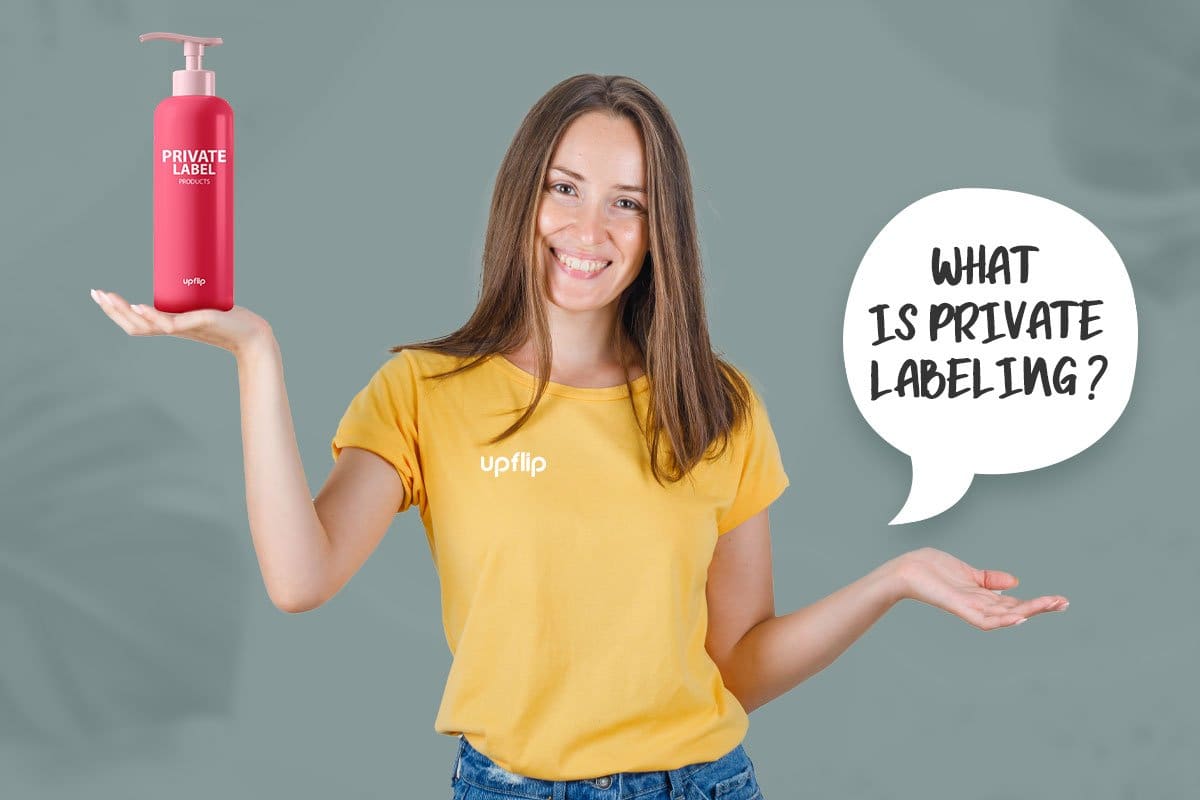 Private label products are products created by a manufacturer with the intent for an exclusive third party to sell them using a different brand name. Private labeling removes the need to invest in high-priced equipment by paying an existing manufacturer for the production of goods.
Private label businesses are growing increasingly popular in the ecommerce field thanks to the reduced startup costs of a private label brand.
Private label products are products created by a manufacturer with the intent for an exclusive third party to sell them using a different brand name. Private labeling removes the need to invest in high-priced equipment by paying an existing manufacturer for the production of goods.
Private label businesses are growing increasingly popular in the ecommerce field thanks to the reduced startup costs of a private label brand.
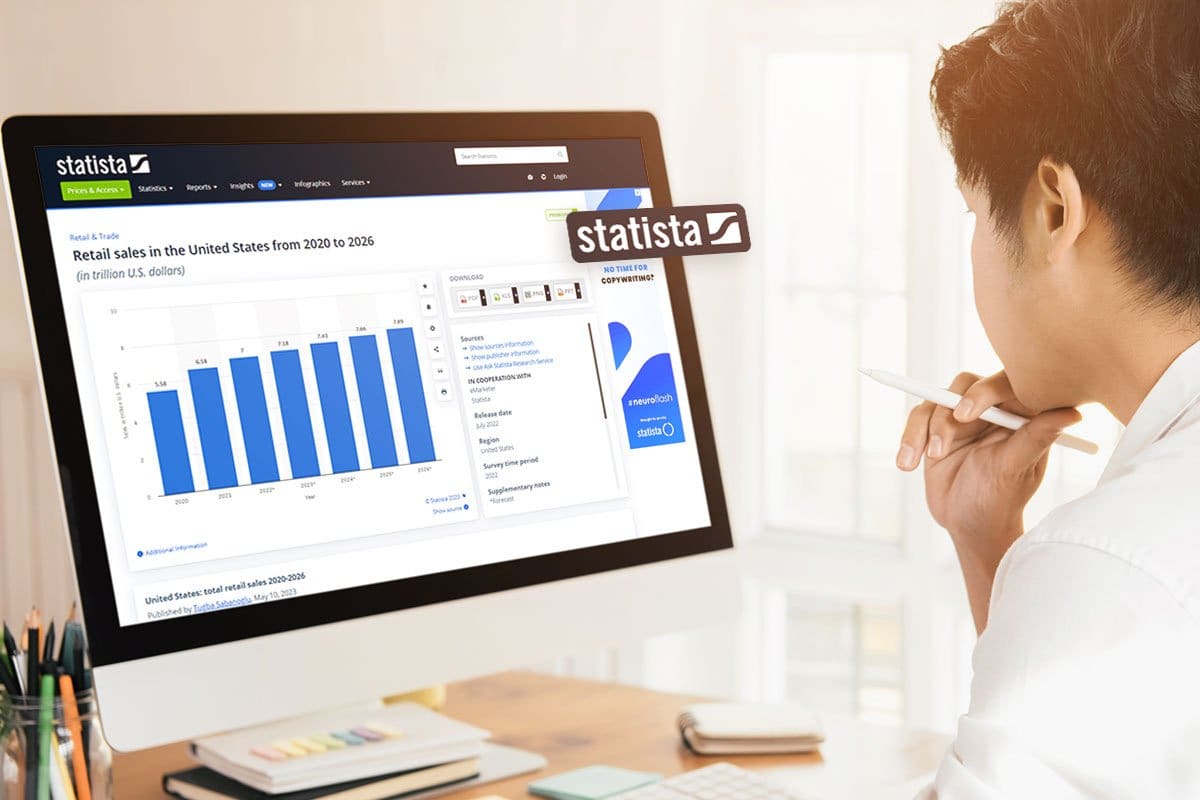 According to Statista, private label products accounted for $6.6 trillion of 2021 GDP and are projected to hit $7.9 trillion in 2026. This includes big brands that offer their own branded products. To draw inspiration from which products sell most, look at the major retail private labels:
According to Statista, private label products accounted for $6.6 trillion of 2021 GDP and are projected to hit $7.9 trillion in 2026. This includes big brands that offer their own branded products. To draw inspiration from which products sell most, look at the major retail private labels:
 We pulled a list of commonly searched private label, white label, and branded products from ahrefs.com to find out what industries use the most private label-ready products. If you’re looking for a niche market, consider these private labeling ideas:
We pulled a list of commonly searched private label, white label, and branded products from ahrefs.com to find out what industries use the most private label-ready products. If you’re looking for a niche market, consider these private labeling ideas:
 Private labeling will require a contract between your business and the third party manufacturer. The contract terms may be dictated by the private label manufacturer, the private label, or negotiated.
If you are using print-on-demand, the manufacturer will almost always dictate the terms, while terms for a custom-made product will be negotiated.
Even when terms are negotiated, there are some specifics that may be unchangeable, like the minimum order quantity (MOQ) or quality controls.
Now that you understand the process of private labeling, let’s circle back to where to find private label products to start your business.
Private labeling will require a contract between your business and the third party manufacturer. The contract terms may be dictated by the private label manufacturer, the private label, or negotiated.
If you are using print-on-demand, the manufacturer will almost always dictate the terms, while terms for a custom-made product will be negotiated.
Even when terms are negotiated, there are some specifics that may be unchangeable, like the minimum order quantity (MOQ) or quality controls.
Now that you understand the process of private labeling, let’s circle back to where to find private label products to start your business.
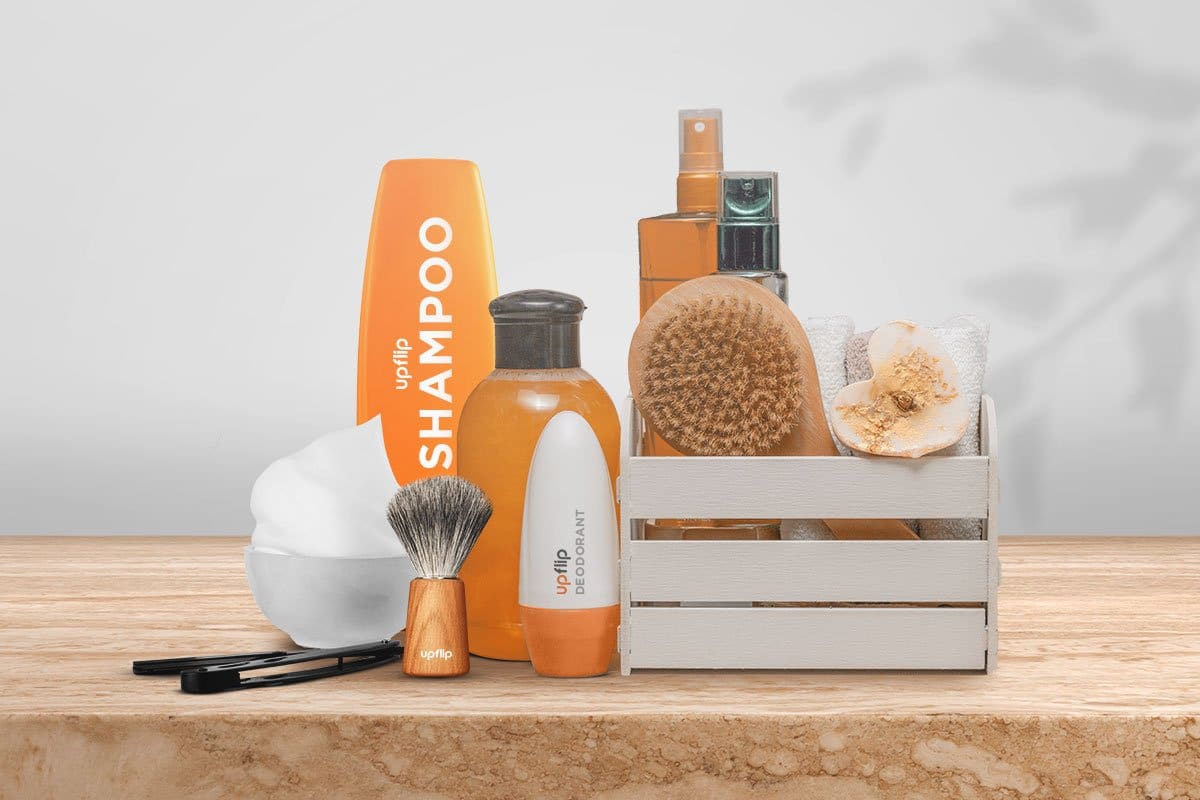 This category includes the following search terms:
This category includes the following search terms:
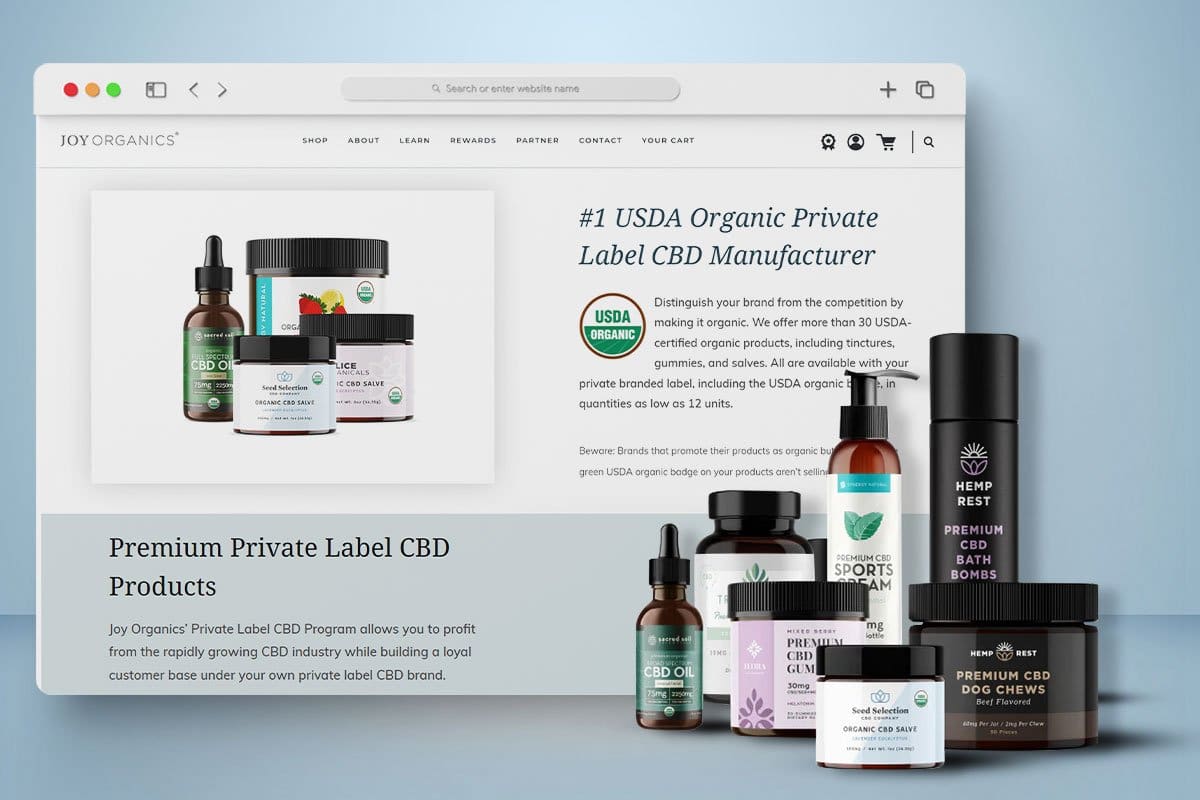 To find hemp and CBD private label products to sell on Amazon and other sites, search terms like:
To find hemp and CBD private label products to sell on Amazon and other sites, search terms like:

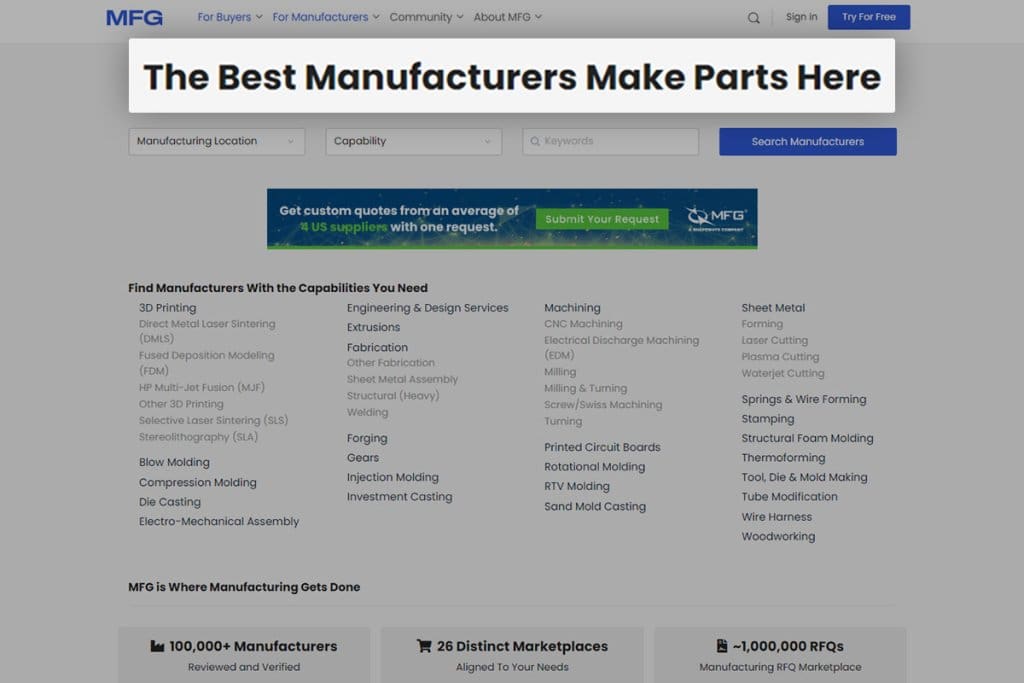 Another popular directory is MFG. You can search suppliers by continent. This directory is over 20 years old and allows you to find manufacturers or create a free profile to request quotes and use other features. While I haven’t dug deep into MFG’s database, they seem to be more focused on metals and plastics.
Another popular directory is MFG. You can search suppliers by continent. This directory is over 20 years old and allows you to find manufacturers or create a free profile to request quotes and use other features. While I haven’t dug deep into MFG’s database, they seem to be more focused on metals and plastics.
 After you have sourced your private label products, you’ll need to set up the system to sell your private label goods. You’ll need to perform the following steps when you have private label products to sell.
After you have sourced your private label products, you’ll need to set up the system to sell your private label goods. You’ll need to perform the following steps when you have private label products to sell.
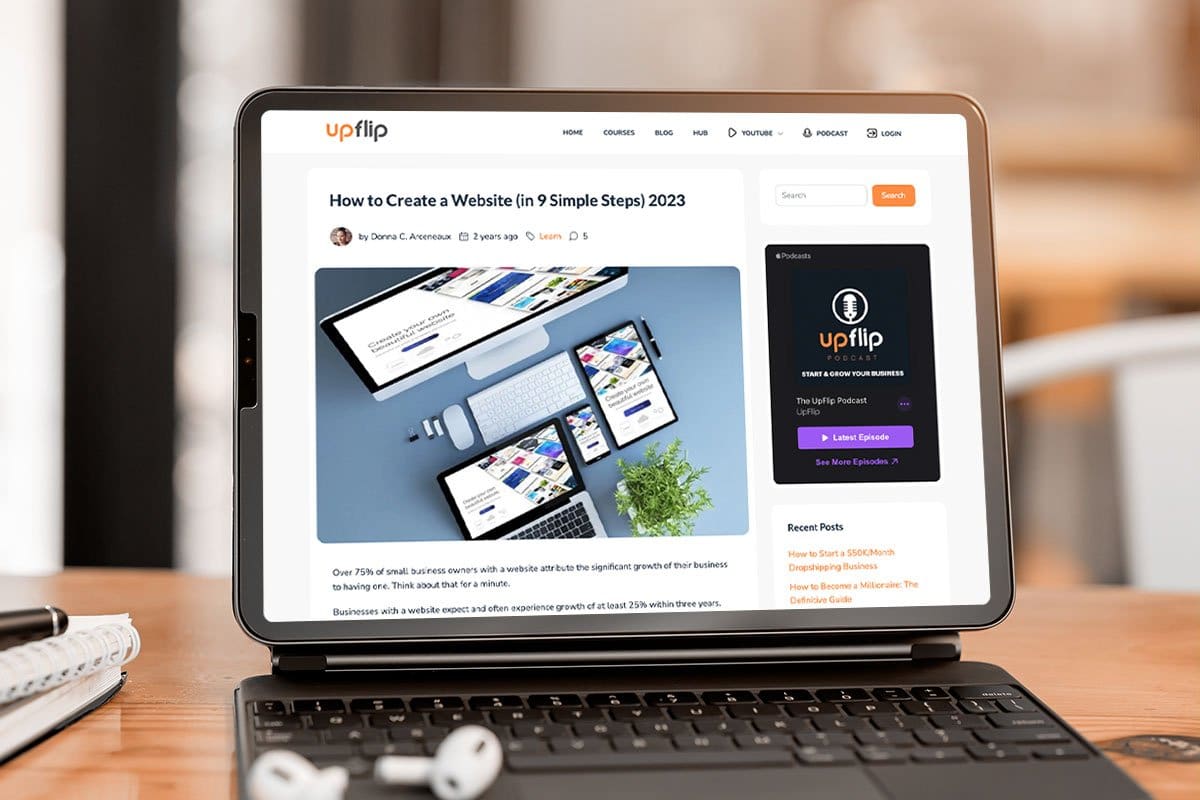 eCommerce business models make it easy for a business owner to build their own websites and ecommerce stores. This is really important when you have private label products to sell (I’ll tell you more in our cautionary tale). A private label product company will need to:
eCommerce business models make it easy for a business owner to build their own websites and ecommerce stores. This is really important when you have private label products to sell (I’ll tell you more in our cautionary tale). A private label product company will need to:
[su_note note_color="#dbeafc"]
 After you’ve written content for your private label business, you should share it on social media. Make sure the content fits both your private label business and the social media platform you share it on. Some types of content perform better on certain social media platforms:
After you’ve written content for your private label business, you should share it on social media. Make sure the content fits both your private label business and the social media platform you share it on. Some types of content perform better on certain social media platforms:
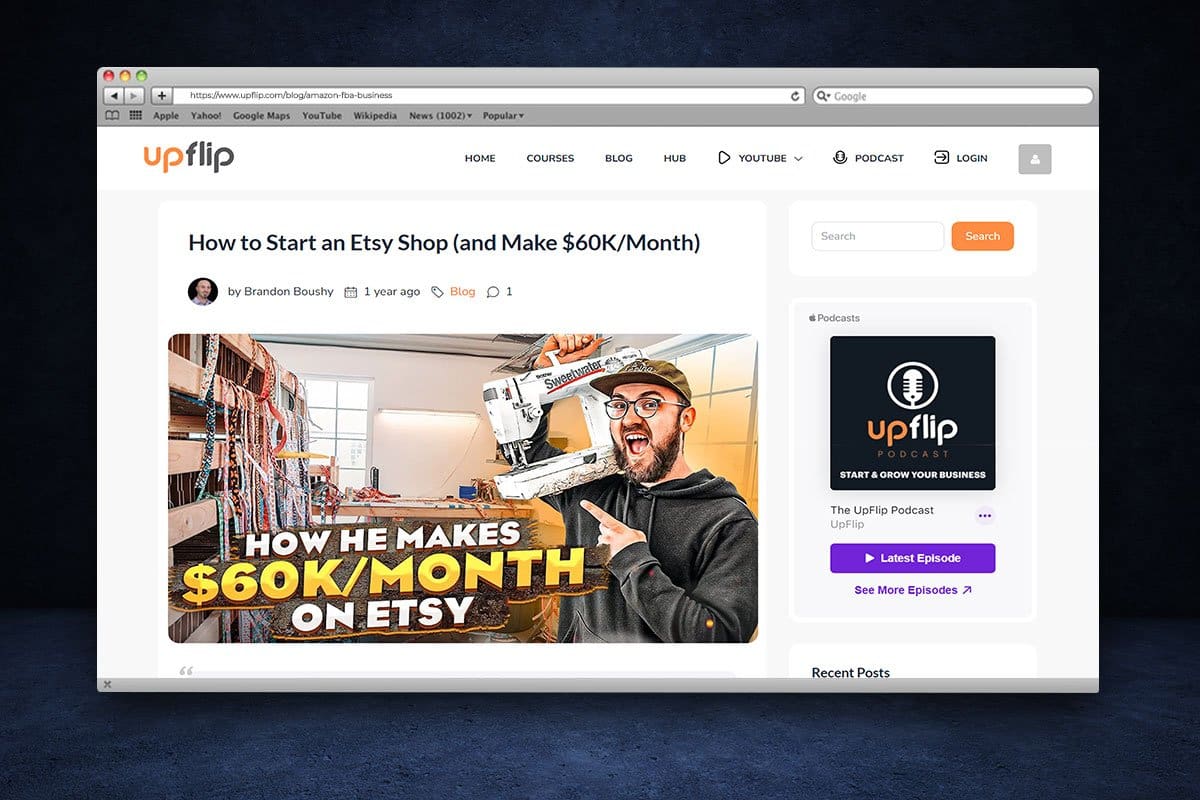 Create an online store on every marketplace you can to get your private labeling in front of as many eyes as you can. According to SimilarWeb, the top places to sell private labeled products are:
Create an online store on every marketplace you can to get your private labeling in front of as many eyes as you can. According to SimilarWeb, the top places to sell private labeled products are:
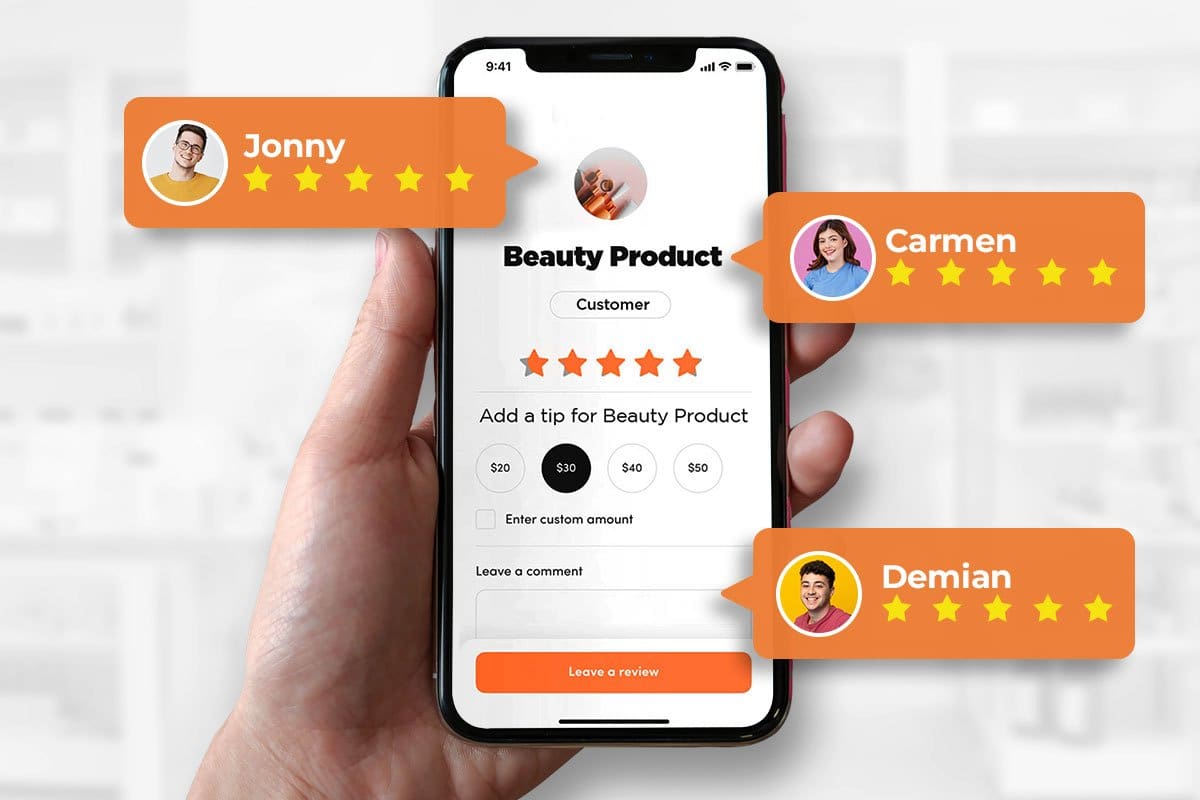 No brand starts with instant name recognition. You’ll need to get reviews for your private label to help overcome poor consumer perception of private and white label products.
Once people see that a company has great product reviews, they are more likely to accept that the brand identity isn’t just trying to make higher profit margins on generic products.
One of the best ways to do this is to automate requests for reviews several days to a week after the consumer has received the product. (Be careful though. Amazon private label products can get in trouble if they request reviews through means other than the standard product review process.)
No brand starts with instant name recognition. You’ll need to get reviews for your private label to help overcome poor consumer perception of private and white label products.
Once people see that a company has great product reviews, they are more likely to accept that the brand identity isn’t just trying to make higher profit margins on generic products.
One of the best ways to do this is to automate requests for reviews several days to a week after the consumer has received the product. (Be careful though. Amazon private label products can get in trouble if they request reviews through means other than the standard product review process.)
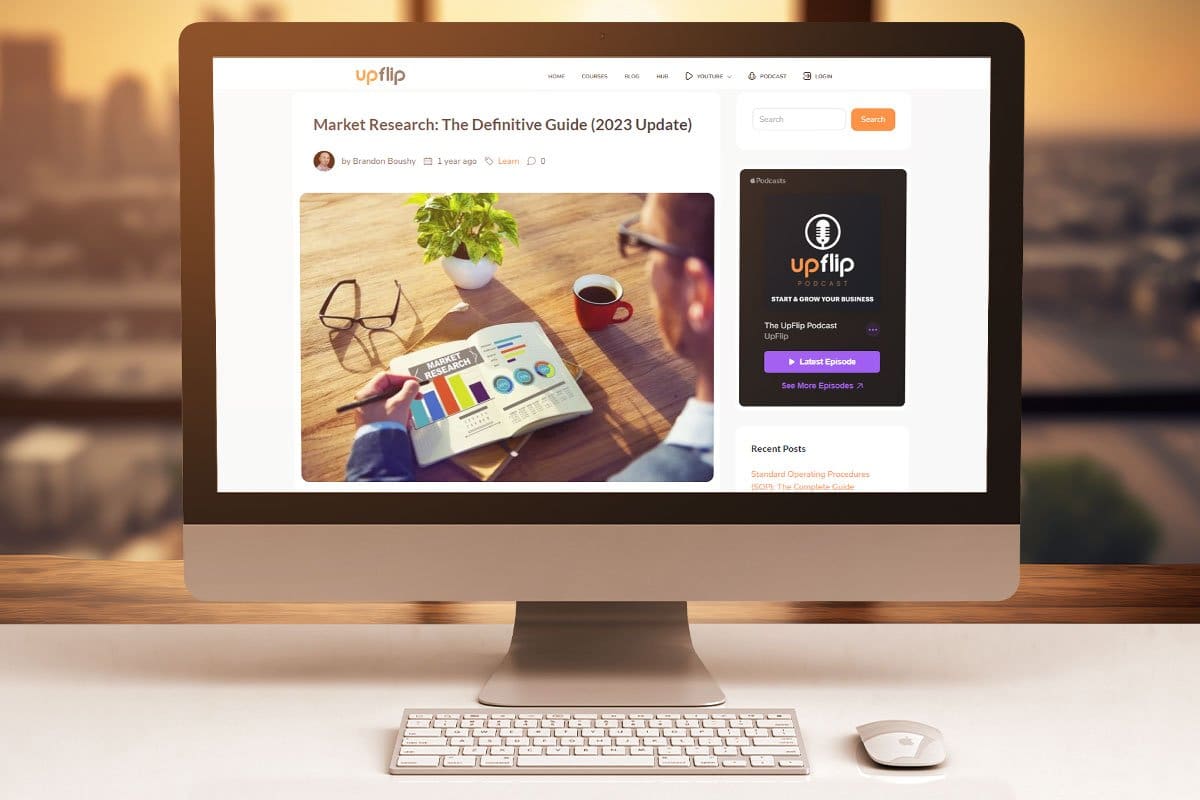 You’ll want to research Amazon’s seller options to decide which one you want to use. Most Amazon sellers use the FBA service, in which the manufacturer ships your bulk goods to Amazon and Amazon fulfills the order for a referral fee between 5 and 20%.
Make sure to read the fees really well because they impact pricing and profitability.
One particularly useful trick you can use with Amazon FBA is working with a dropshipper to produce your custom products. Place an original bulk order that is sent to the Amazon warehouse, then every time a product is ordered, have Amazon ship it, send the dropshipper money for more, and you keep the profits.
Just like that, you get the benefits of Prime and dropshipping all in one.
You’ll also want to research the demand for the product category. Make sure you study the number of competitors and the number of searches for similar products. Michael Jackness, the owner of treadmill.com and Amazon FBA private label stores, told us:
[su_quote]Picking the right niche and market is really important. It’s gotten more expensive to get the customer, so you need to be able to sell to them more than once.[/su_quote]
Hear more from Michael to learn how he created a $9 million annual ecommerce company.
Learn more about market research.
You’ll want to research Amazon’s seller options to decide which one you want to use. Most Amazon sellers use the FBA service, in which the manufacturer ships your bulk goods to Amazon and Amazon fulfills the order for a referral fee between 5 and 20%.
Make sure to read the fees really well because they impact pricing and profitability.
One particularly useful trick you can use with Amazon FBA is working with a dropshipper to produce your custom products. Place an original bulk order that is sent to the Amazon warehouse, then every time a product is ordered, have Amazon ship it, send the dropshipper money for more, and you keep the profits.
Just like that, you get the benefits of Prime and dropshipping all in one.
You’ll also want to research the demand for the product category. Make sure you study the number of competitors and the number of searches for similar products. Michael Jackness, the owner of treadmill.com and Amazon FBA private label stores, told us:
[su_quote]Picking the right niche and market is really important. It’s gotten more expensive to get the customer, so you need to be able to sell to them more than once.[/su_quote]
Hear more from Michael to learn how he created a $9 million annual ecommerce company.
Learn more about market research.
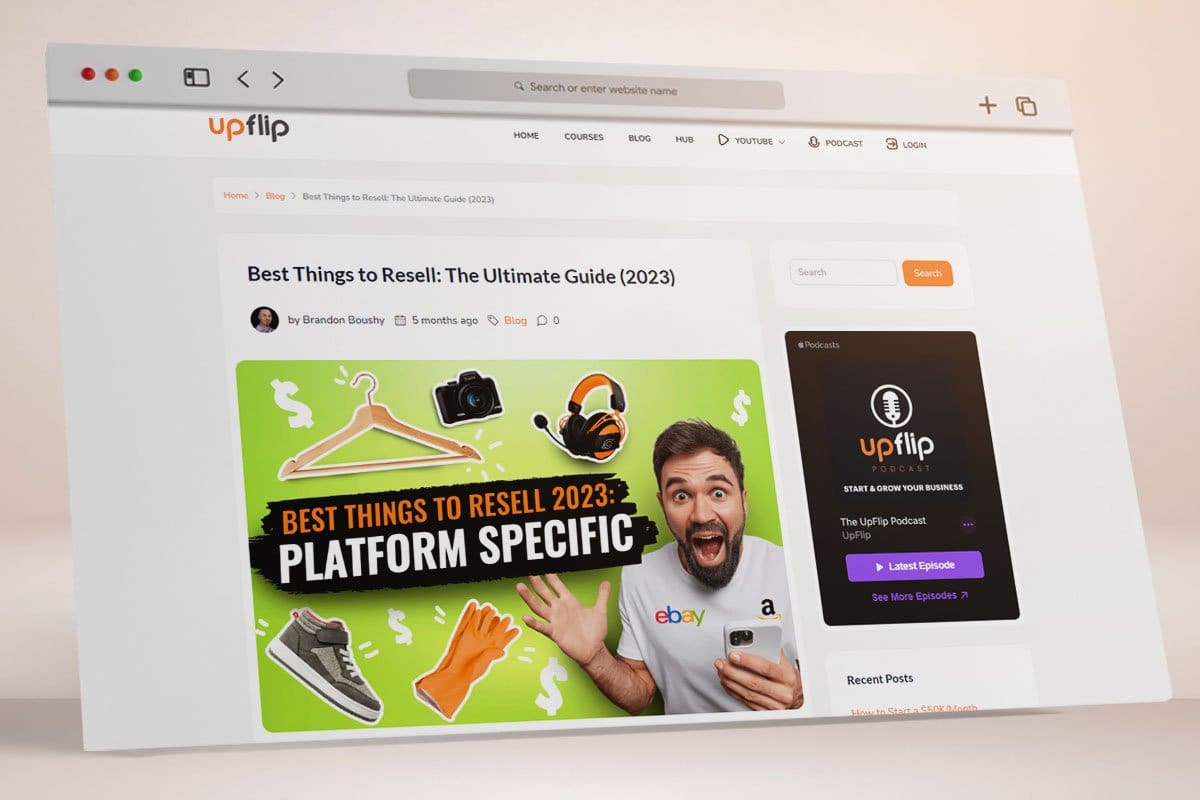 We’ve already provided a list of private label products and where to find them, but you should check out our best things to resell blog for more information on the best products to private label.
We’ve already provided a list of private label products and where to find them, but you should check out our best things to resell blog for more information on the best products to private label.
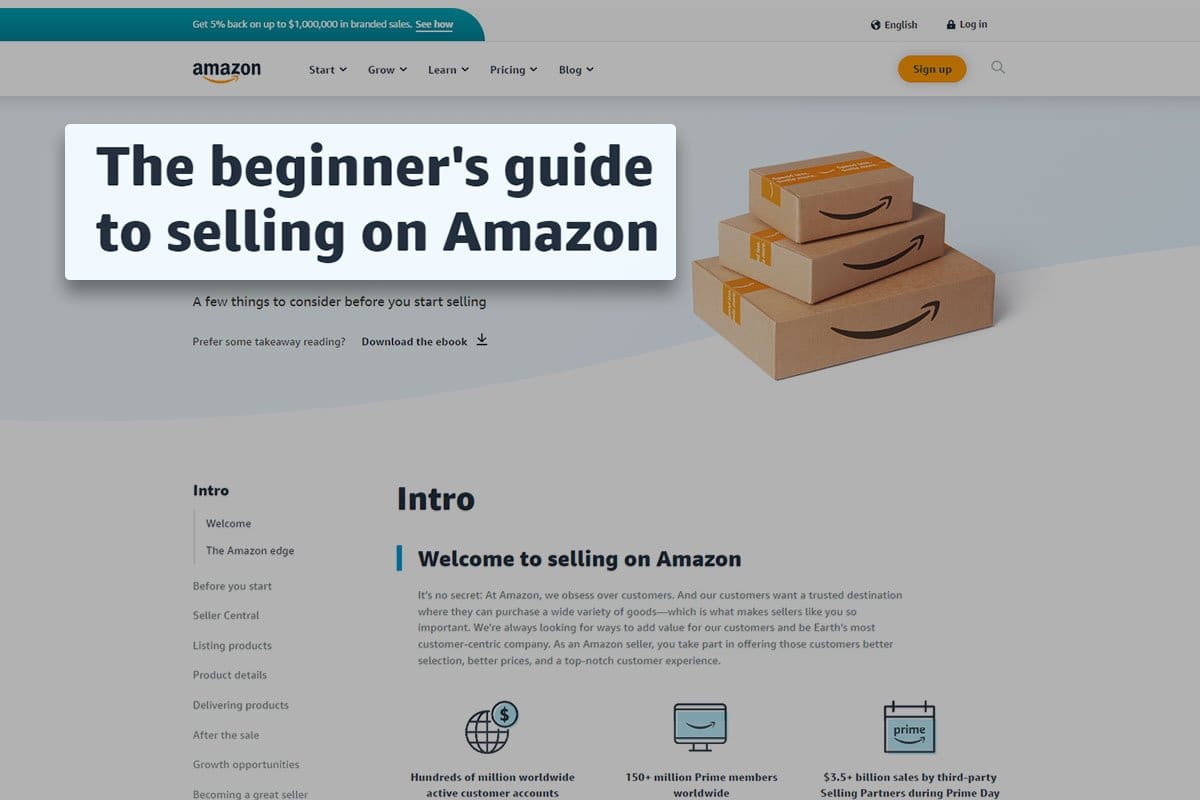 To make the most of Amazon, you need to have an Amazon FBA account. Sending your products to Amazon’s warehouse means they qualify for Amazon Prime. You can also qualify for Prime with self fulfillment (but there are more stringent requirements). I strongly suggest reading Amazon’s guide before getting started as well.
To make the most of Amazon, you need to have an Amazon FBA account. Sending your products to Amazon’s warehouse means they qualify for Amazon Prime. You can also qualify for Prime with self fulfillment (but there are more stringent requirements). I strongly suggest reading Amazon’s guide before getting started as well.
This comprehensive blog article on the various types of vending machines offers valuable insights into the diverse range of options available in the vending industry. Drawing from my personal encounters with vending machines in different settings, including airports, malls, and office buildings, I found the breakdown of each vending machine type to be both informative and engaging. The article effectively categorizes vending machines based on their offerings, such as snacks, beverages, and even specialized items like ice cream or electronics, providing readers with a clear understanding of the versatility within the vending market. As someone intrigued by entrepreneurial opportunities, this article serves as an excellent resource for exploring the potential avenues for investment and business growth within the vending industry.
 Inbox
Inbox 
Learn from business failures and successes in 5 min or less. The stories, frameworks, and tactics that will make you a 10x better founder.
 Join our 45,000+ entrepreneurs
Join our 45,000+ entrepreneurs